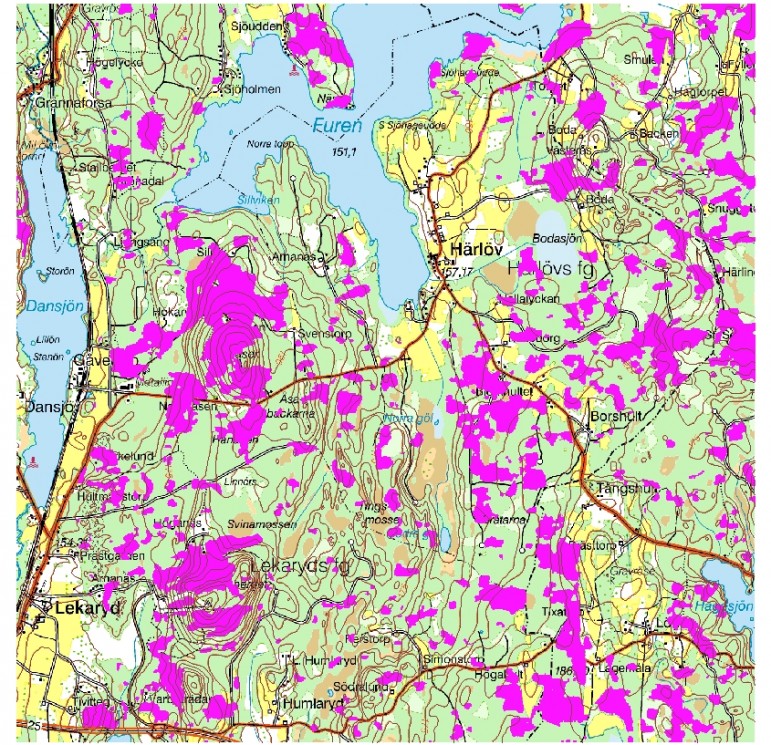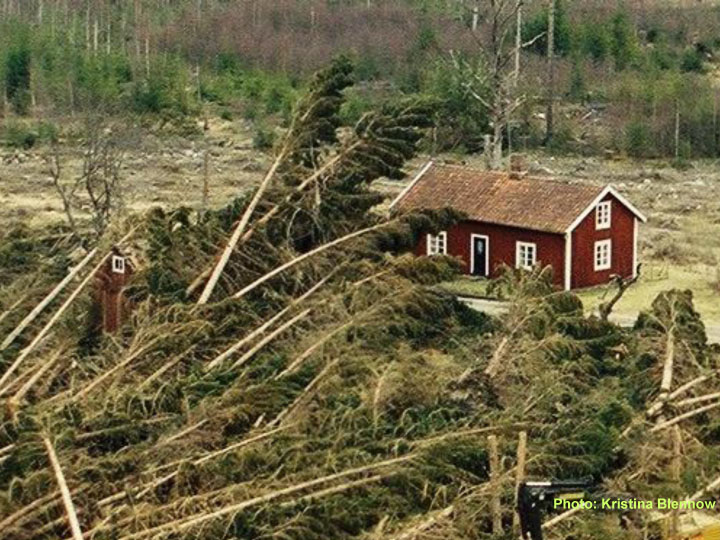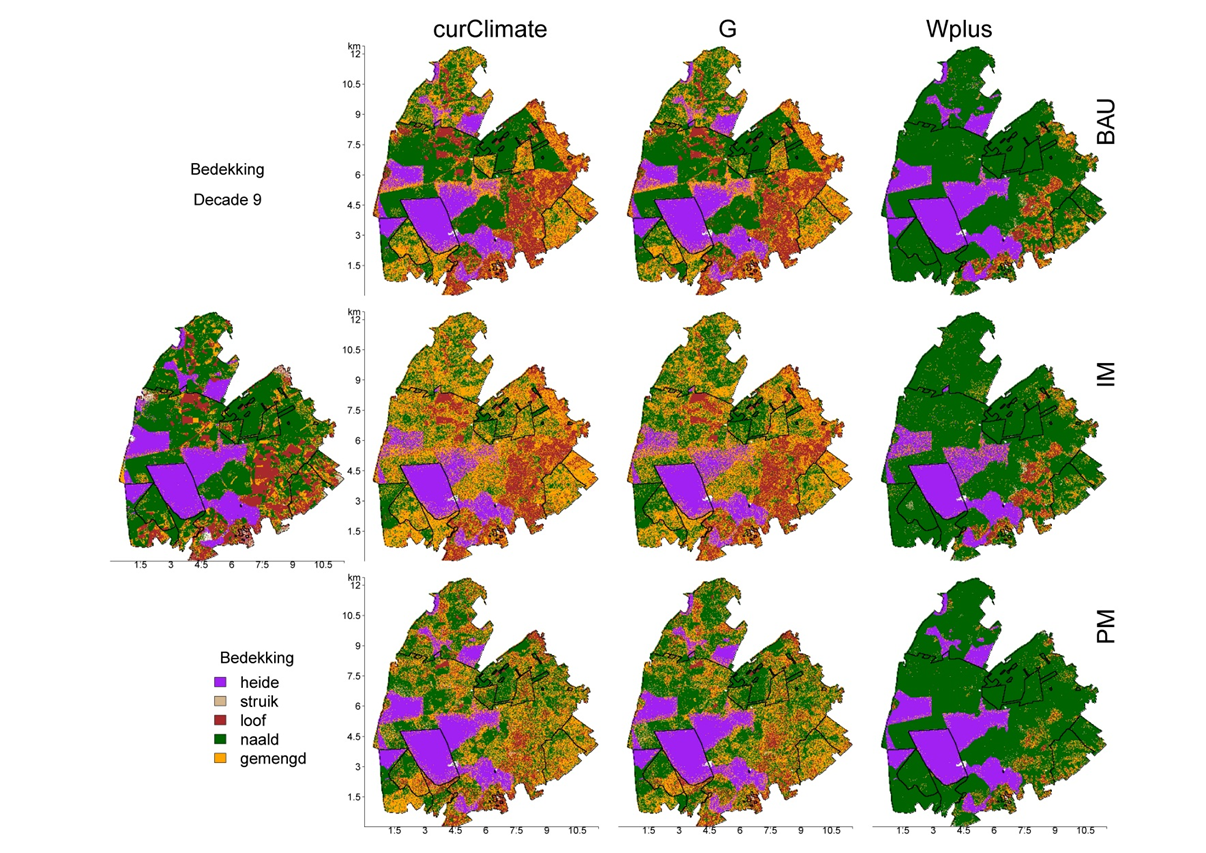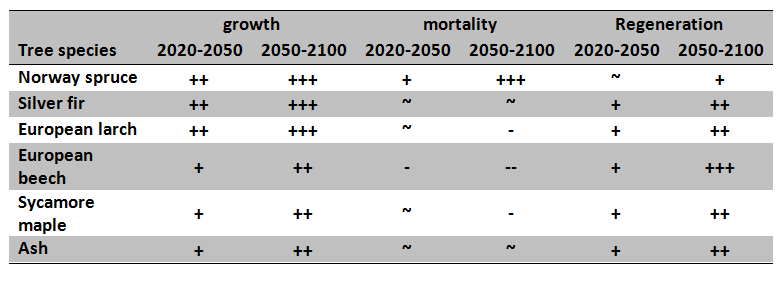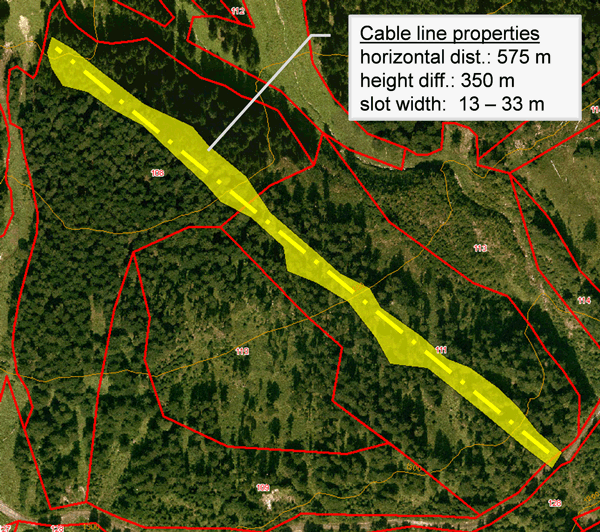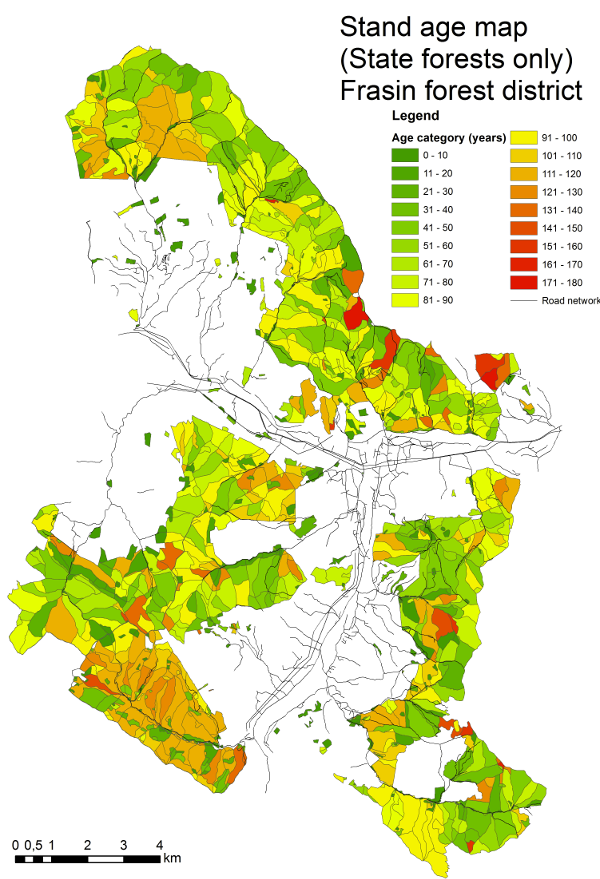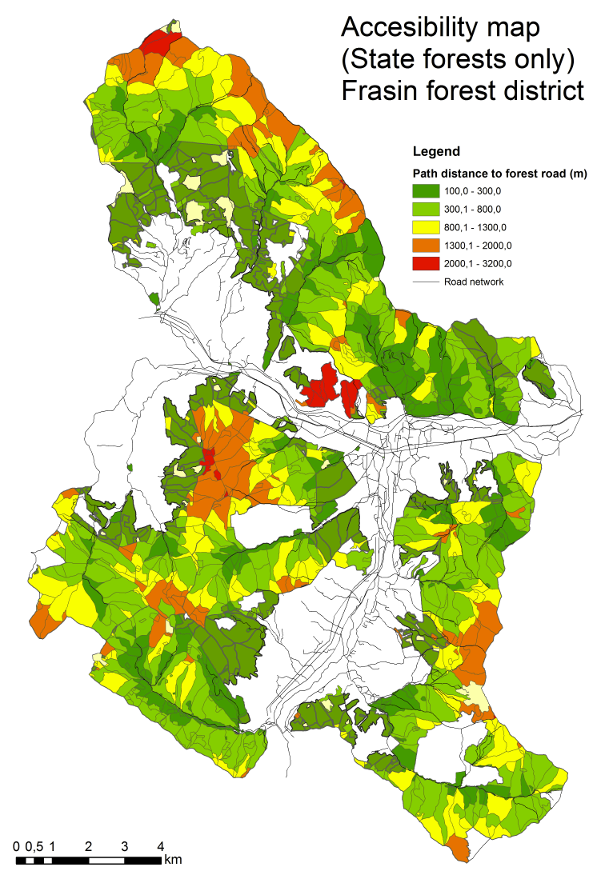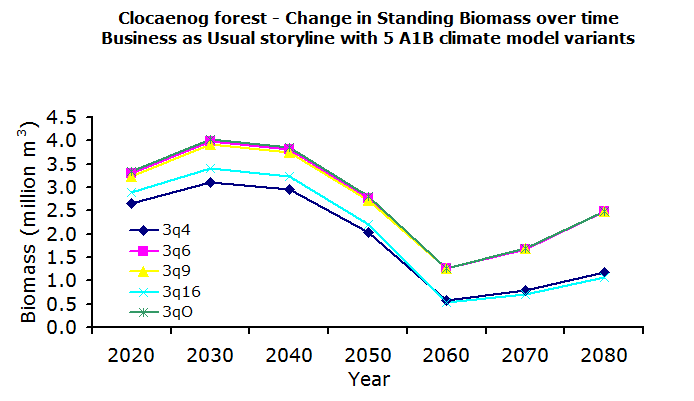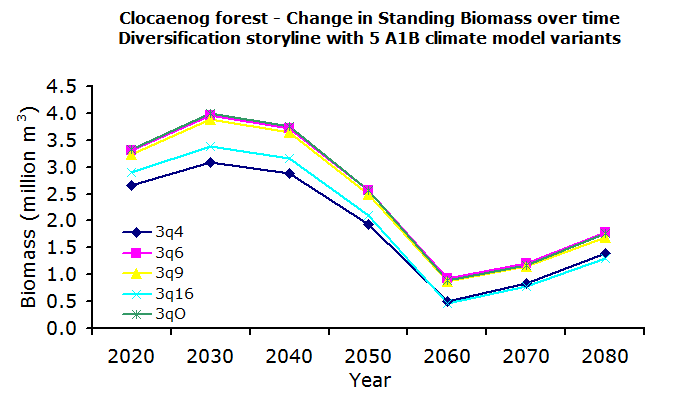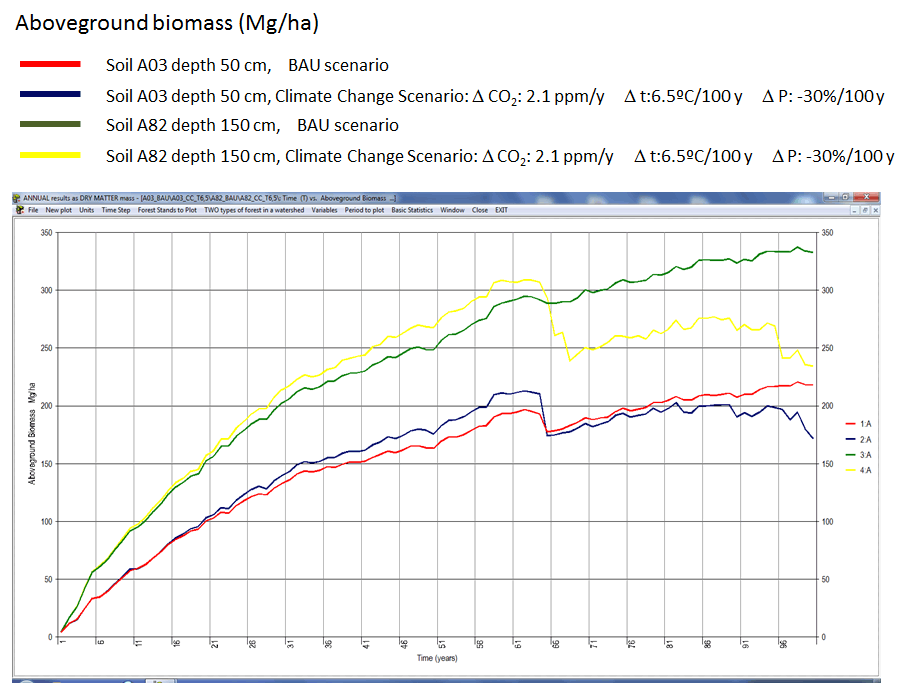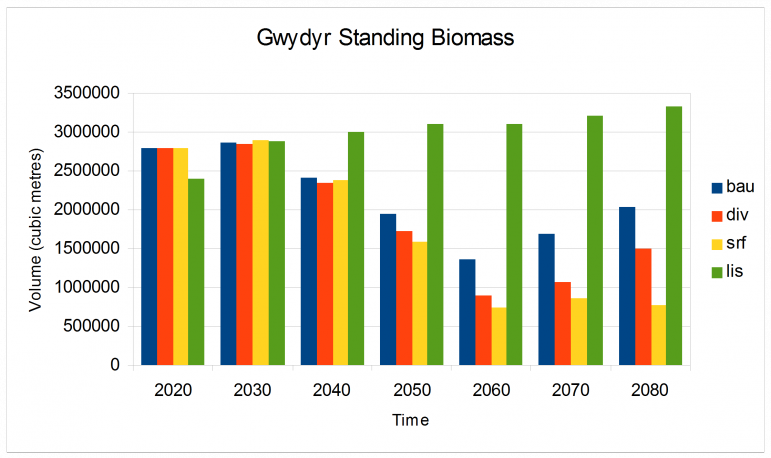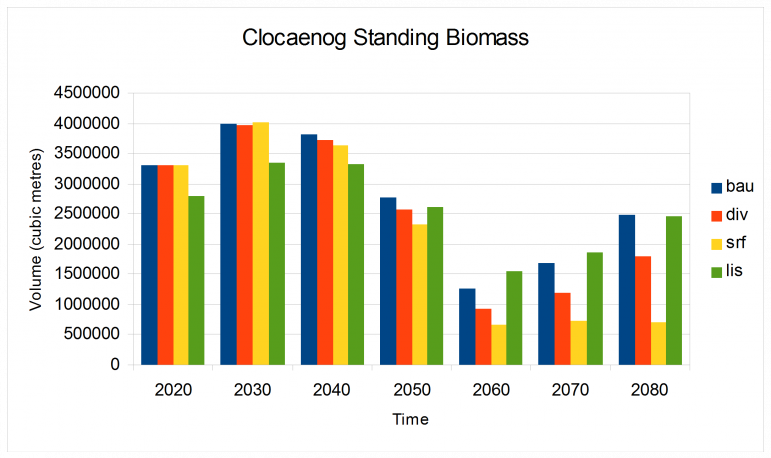Use the filter-criterias in the right sidebar to narrow the displayed FAQ according to your needs.
Which adaptive measures appear as a suitable response to the changing climate in order to sustain the provision of the demanded ecosystem services? What is the recommendation to the forest manager? Panagyurishte (Bulgaria)
There are few options available to adapt the forest management in the Panagyurishte to a changing climate.
One is to support the increasing of the share of more drought tolerant species as Turkey oak, despite the less valuable timber production of it.
Another potential measure is to implement more intensive regeneration treatments on mature coppice stands. This would respond to two important management goals – to convert coppice oaks stands in to high ones and to establish young, high forests stands, which theoretically would be more flexible to environmental changes.
From the other side, the competition of new stumping sprouts after the regeneration felling is an important ecological and economic obstacle, which might frustrate the transformation. We may expect that more stands in the future will own mixed origin. The problem with the total timber productivity of the future stands should not be underestimated as well.
Reducing the fire risk means more intensive thinning, as well as diminishing the share of pure conifer plantations. These measures could meet some economic obstacles, since many of them are not profitable.
Finally, the strictly even age structure of the current existing stands favors its occurrence again in to next generations. Generally pure, even age stands with simple (homogeneous) spatial structure are less resilient to different stress factors. The establishing of a more heterogeneous stands structure needs longer time and additional financial and human resources, which will reduce the implementation of these treatments.
The adaptive management scenario (AM) includes silvicultural treatments which are convenient, well-known and possible according to both the expert opinions and legal management conceptions. They include shortening the rotation age of the coppice stands for conversion in to high and relatively intensive tending and thinning in to young stands.
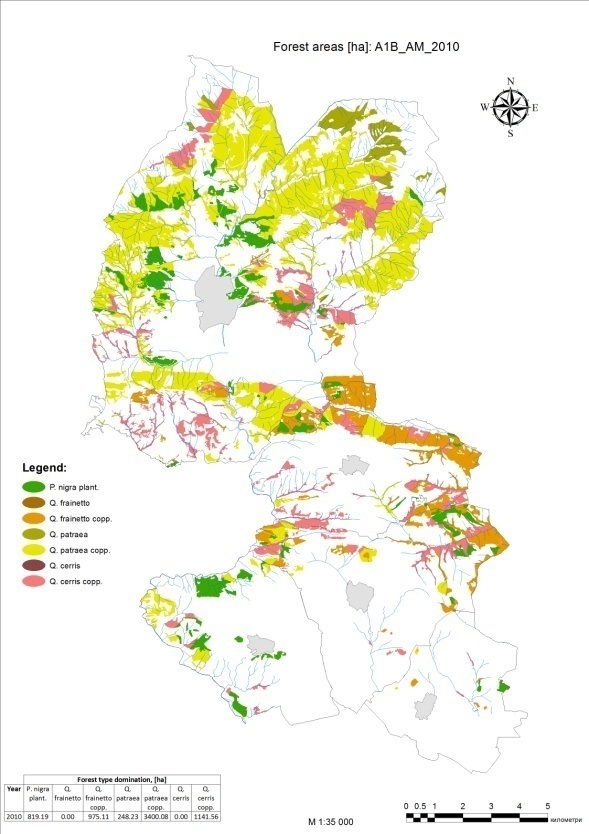
Fig. BG-11. Species and origin dynamics of forest stands in case study Panagyuristhe by moderate climate scenario A1B and AM management (2010)
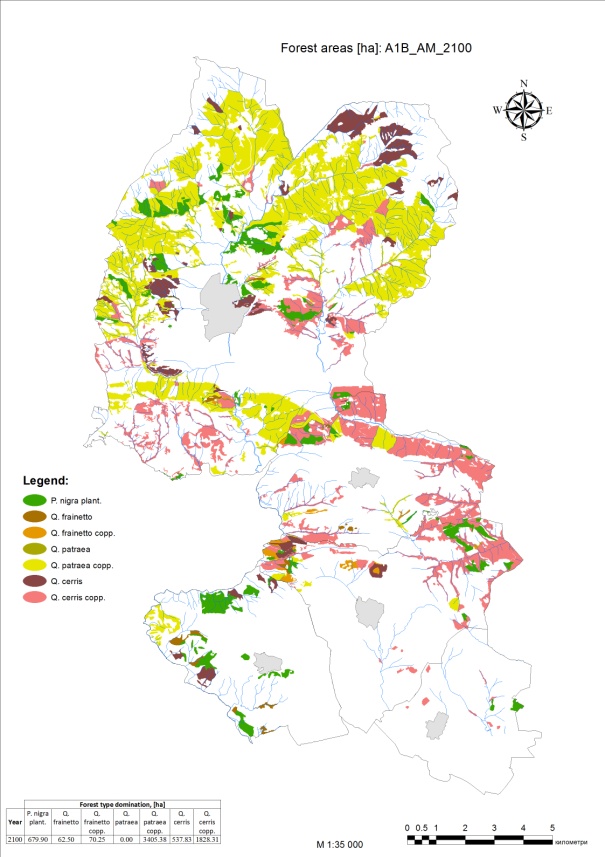
Fig. BG-12. Species and origin dynamics of forest stands in case study Panagyuristhe by moderate climate scenario A1B and AM management (2100)
What do the AM projections predict about?
- Tree species composition and stands origin;
- Stands growth and potential timber harvest;
- Volume stock per hectare of the stands.
Tree species composition and stands origin: In all climate scenarios, adaptive management scenarios determine higher share of high forests in the case study area in comparison with current practice (BAU). More intensive regeneration felling according to AM will lead to increasing the areas of young stands dominated by trees of seed origin in short to mid-term outlooks. Long-term projections predict back-turn to coppice dominate origin of the existing stands. The share of the most adaptive Turkey oak increase faster in short-term run replacing more often Sessile oak and pine. Important conclusion of the long-term projection is that the conception of total conversion of the coppice oak stands will not be fulfilled, never than the less AM scenario promotes higher future share of high forests, than BAU.
Stands growth and potential timber harvest: Potential timber harvest will decrease during the projection time, since the main annual increment decreases for both AM and BAU scenarios and both coppice and high stands. AM management require urgent, short-term harvest in all coppice stands, which will decrease considerably after 2020. This rises the potential problem concerning the lack of ability of the stands to supply the timber demand in mid and long-term outlook, if assumed that it will keep the current level. From the other hand the risk of men-caused fires will diminish since less human activities will be possible in more dense young forests.
Volume stock per hectare of the stands: AM promotes the relatively intensive and steady decrease of the standing volume per hectare of the existing forests in short and middle term period for all stands. This connects to the more intensive regeneration felling in the short-term run for oaks stands. The total area of the pure pine stand decreases since native species (oaks) become dominants. In the long term perspective the AM scenario supports higher volume stock in comparison with the BAU for all oaks stands. The projections represent volume per hectare in the end of the century equal to the current one. In a few words, the AM promotes ability of the future coppice oaks stands to produce and support aboveground biomass, like coppice forest today. This mean that the stands will be similar to the current ones and will consist from closed forests and they could guarantee their protective and other environmental services, despite the low timber production and supply.
see also this FAQ (especially the figures).
For a summary of the results and differences between the AM and the BAU scenarios see Table BG-3.
Table BG-3.Comparison between the AM and the BAU management concerning legal management goals, related to different forest ecosystem functions in the Panagyurishte case-study (+ positive impacts, – negative impacts, ~ indifferent).
| Management goals |
2010-2020 |
2020-2050 |
2050-2100 |
|||
| Management scenario |
AM |
BAU |
AM |
BAU |
AM |
BAU |
| Conversion the coppice to high |
++ |
+ |
~ |
+ |
– |
–– |
| Production of construction timber |
+ |
~ |
– |
– |
— |
— |
| Fuel-wood supply |
+ |
~ |
~ |
– |
— |
— |
| Protection of erosion |
~ |
~ |
– |
— |
+ |
~ |
| Landscape improving, recreation |
~ |
~ |
– |
~ |
+ |
– |
| Source of clean air |
~ |
~ |
– |
– |
+ |
~ |
Some additional conclusions:
The AM scenario provides higher species diversity and performs a steady share of coniferous;
No significant differences in BAU and AM in terms of yield, growth and other stand characteristics (density, composition, origin) are observed;
The potential room for adaptation in terms of traditional silvicultural aims for all coppice forests is narrow;
The AM scenario moderates potential harm concerning timber supply and forest diversity;
These should lead to changes in long-term goals and traditional expectations from these forests.
Are the tree species in the forest sensitive to climate change? Carpathians (Romania)
The typical stands in the case study area are composed of Norway spruce and beech, often in mixture. The tree species are sensitive to drought, windfall and insect attack.
The typical stands in the case study area are composed by Norway spruce, silver fir and beech, often in mixture. Beech, followed by silver fir is sensitive to drought and the Norway spruce is the most sensitive to windfall and insect attack.
Although there is much empirical evidence of frequent drought episodes, there are no studies available to quantify and detail droughts in this region. The discussions with the forest management authorities in the case study area identified drought as being an increasingly important factor for tree stress, potentially leading to dieback. Beech is widely known as a drought-sensitive species, and would likely respond to more frequent or intense droughts by reducing its productivity. The Norway spruce growing in mixture with other coniferous species in the region had the strongest reaction to drought. The consequences could be a drop in productivity but also an increase in trees’ susceptibility to insect attacks.
The stands can be regenerated naturally or with some planting complements. However, a shift in species composition could be observed in the future, as beech tends to gain space to the detriment of Norway spruce, but there are not enough evidences to put this shift to the climate change.
The Norway spruce and larch are sensible to the insect attack moth Lymantria monacha. Attacks on Norway spruce during an outbreak can lead to total defoliation. Trees with defoliation exceeding 30% are unlikely to recover. Total or partial defoliation weakens trees and promotes secondary pest attacks (e.g. from bark beetles). Major bark beetle attacks (in the last 10 years) have been reported since 2003, when outbreaks of insect populations followed the existence of a large quantity of breeding material from the 2002 windfall. A high level of bark beetle population persisted until now, with a large number of healthy spruce trees being attacked annually. The damage can potentially be considerable, with several thousands m3 of wood to be cut.
Are forests sensitive to climate change? Kronoberg (Sweden)
The distribution of forest tree species is expected to be affected by climate change which may have severe economic consequences (Hanewinkel et al. 2012). For example, the growth of Norway spruce is expected to suffer from water stress especially in south-eastern Sweden on sites with low water-holding capacity.[ 1] Studies assuming that the same tree species as today will be used in forestry indicate that the tree growth in Kronoberg County will in general increase under a warmer climate. Results from our simulations in the MOTIVE case study area, where we have applied business as usual forest management under both current climate and a warmer climate (A1B scenario), indicate that tree growth will increase by approximately 15% during the period 2001-2100 due to a warmer climate. The increase in growth is indicated to affect average standing volume (5%) and harvest volumes (15%) and to increase net incomes from forest operations. Due to increased growth, rotation periods will be shorter and forestry in general more intensive in terms of the number of forest operation activities per unit of time. The average number of activities per stand and year is indicated to increase by 6%, mainly in terms of final fellings and regenerations. For Norway spruce the average age at final felling under a warmer climate is indicated to reduce by seven years until the period 2071-2100. The effects of the changing climate on the forest will increase gradually which might affect also the provisioning of opportunities for hunting and recreation. Our simulation results show only small effects, however, on average moose habitat suitability index (Kurtilla et al. 2002) and recreation index (Lindhagen 2005) during the period 2001-2100.
At the same time climate change is expected to lead to increasing disturbances from extreme weather events, insect outbreaks, fungi etc. with consequences on services and benefits from the forest. While increasing growth might lead to higher financial return, the quality and or the quantity of the wood, and indeed the financial return, will reduce should insect outbreaks, wind damage or some other risk materialize. Furthermore, a changing climate might lead to effects that so far remain unidentified.
Wind damage to forests in southern Sweden has increased during recent decades (Gardiner et al., 2010). This is because of changes in the state of the forest as well as form a changing climate. Kronoberg County was the most extensively damaged county in a major wind damage event on 8 January, 2005, when damage occurred on 14.1% of its forest area (SFA 2006) (Figures SE-1 and SE-1). The wind damage was mainly done to Norway spruce (SFA 2006). More than a fourth of the forest area used for the MOTIVE simulation study was damaged during the 2005 wind damage event (based on data from the Swedish Forest Agency) (see Figure SE-1). Pervasive wind-related reduction in growth of the remaining forest during three years after the storm has recently been shown (Seidl & Blennow 2012). The growth reduction is of a magnitude similar to the total secondary damage incurred by spruce bark beetles during the corresponding period of time after the storm.
Are the tree species in the forest sensitive to climate change? South-East Veluwe (Netherlands)
The simulated tree species distribution in 2110 (Figure VE-1) shows clear differences between current climate and moderate climate change on the one hand, and the more extreme climate change scenario on the other hand. Under current conditions or moderate climate change, beech is expected to increase in large parts of the area. However, increased drought under climate change leads to a loss of beech, in favour of drought-resistant, coniferous species, mostly Scots pine on the poor soils and Douglas fir on the somewhat richer soils. Broadleaved, drought-sensitive species like oak and beech can only maintain dominance in the south part of the area with higher water availability. The climate effect on the tree species distribution in the more extreme W+ scenario will have a larger influence on the future tree species composition than adaptive management can compensate for. Research has shown that different provenances of Douglas fir have different tolerance to drought. It is likely that such provenances have been used in our case study in the past. In the simulations we have assumed that also in future drought-tolerant varieties are used.
Are the tree species in the forest sensitive to climate change? Prades (Spain)
Most tree species occurring in the area are typical Mediterranean tree species which are medium to extremely drought resistant. It means that they have low risk of cavitation due to drought. The most serious threat of climate change in the area is the increased occurrence of long dry spells. Even Mediterranean species can suffer carbon starvation due to these dry spell, as they need to consume their mobile carbon reserves to overcome such periods. If too recurrent, mobile carbon reserves cannot be replenished in time, with vitality loss as a consequence. This may be the case for holm oak. Eurosiberian species like Scots pine, who find some of their southernmost distribution areas in these mountains are directly threatened by climate change. Scots pine has no possibility to migrate to higher elevations given that they occupy already the highest zone of this geographically isolated mountain.
Are the tree species in the forest sensitive to climate change? Montafon Valley (Austria)
The assessment of tree species sensitivity to climatic changes in the case study distinguishes three key ecosystem processes (a) growth, (b) regeneration and (c) mortality of trees with regard to three time horizonts: (i) short-term (up to 2020), (ii) mid-term (2020 to 2050) and (iii) longterm (2050 to 2100).
Growth
All tree species in the region will actually physiologically benefit from a warmer climate because water supply on most sites is not a limiting factor (current precipitation levels exceed 1100mm/year and decreases in precipitation as expected for the future are of minor importance). Tree growth will increase because of more favorable growing conditions and longer growing seasons.
Regeneration
In the short run, similarly to the expected changes in growth, not severe changes are expected. Mid- to long-term the ecological conditions for regeneration will improve as periods with snow cover will become shorter and growing season length will increase. At intermediate altitudes between 800-1500m this will particularly favour the broadleaved species Fagus sylvatica and Acer pseudoplatanus which will be more competitive relative to Norway spruce.
Mortality
Due to warmer conditions Fagus sylvatica and Acer pseudoplatanus as well as Fraxinus excelsior will be less affected by winter frost. However the future development of early and late frosts remains uncertain. Another important abiotic factor with large uncertainties with regard to the future development is the snowpack on the steep slopes of the Montafon which causes mortality in seedlings due to snow creeping and gliding. If future conditions feature more frequent wet snow precipitation events damages from snow breakage will increase. Wind throw is currently playing only a minor role in the disturbance regime. This is not expected to change in the future. Given the current and projected climatic conditions forest fires are not a concern in the case study region.
For Norway spruce the risk of bark beetle infestations will increase substantially due to better development conditions for poikilothermal insects. Especially during the second half of the 21st century a strong increase in bark beetle (Ips typographus) induced mortality can be expected for Norway spruce. For silver fir the bark beetle risk in the future remains uncertain. There has been less research on insects feeding on Silver fir compared to Norway spruce and the knowledge is still limited. For Fraxinus exc. future development is uncertain because of current severe dieback symptoms caused by the fungus Chalara fraxinea. Reduced precipitation and warmer temperatures may negatively affect conditions for Lachnellula willkommii (larch cancer) and thus improve the growing conditions for European larch.
For a summary of the tree species sensitivities please see Table MO-1.
Are the tree species in the forest sensitive to climate change? Panagyurishte (Bulgaria)
The assessment of tree species sensitivity to climatic changes in the case study distinguishes three key ecosystem processes (a) growth, (b) regeneration and (c) mortality of trees with regard to three time horizons: (i) short-term (up to 2020), (ii) mid-term (2020 to 2050) and (iii) longterm (2050 to 2100).
1) Growth
All tree species in the region will actually physiologically fall out because of the drier climate and the water supply on most sites is a limiting factor (current precipitation levels will decrease up to 120 mm per year and T will rise up to 3.5 degree C which increases the evapotranspiration). The droughts and less favorable growing conditions during the growing seasons cause substantial decrease of the mean annual increment of the forest stands (fig. BG-1).
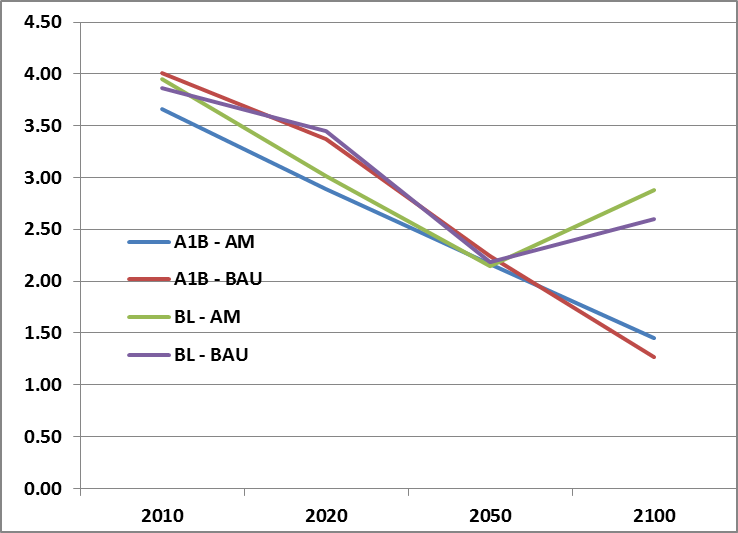
Fig BG-1. Average annual increment (cub.m/ha/year) simulation data for the forest case-study area Panagyurishte, by two climate scenarios (A1B& BL) and both BAU and AM management scenarios
2) Regeneration
In the short-term scale, not severe changes are expected. Mid-term seed regeneration will be still possible for most of the oak coppice stands (which is the important management goal). In long-term, the ecological conditions will worsen seed regeneration since the mature oak trees need favorable climatic condition to produce vital acorns. Young seedlings of seed origin will be more sensitive to drought stress and will be shifted by the young sprouts, which ability to provide more water through their old and well developed root system is higher (fig.BG-2).
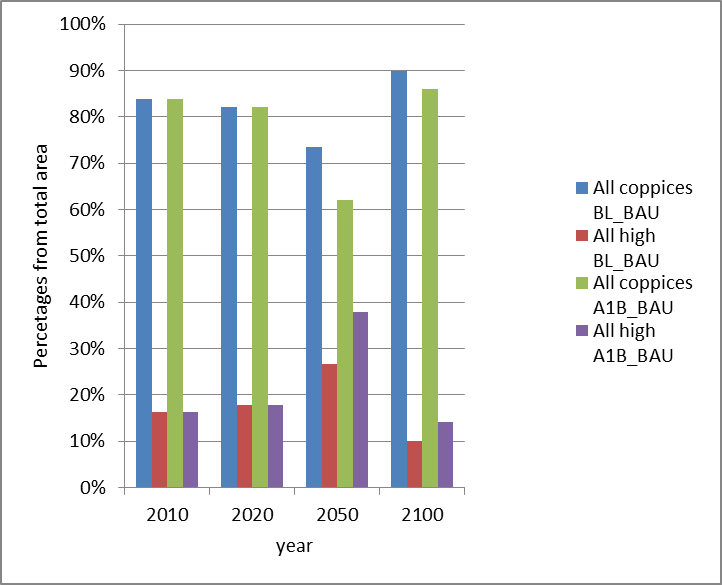
Fig.BG-2. Distribution of forest stands in case study by origin for the two climatic scenarios (A1B & BL) following BAU management scenario.
3) Mortality
Due to the warmer and drier conditions some shortening of the current vegetation period will occur and the more xerophytes tree species will be less vulnerable. More valuable, but mesophyte Sessile oak (Q.petrea) will be most affected by long lasting, dry conditions. Warmer and open winter could provoke earlier blossoming of trees’ buds which could cause damage from later frosts. Constant short vegetation period will lead to a decrease of growth of the existing trees and a reduced stand’s canopy. These will increase the risk of epidemic outbreaks caused by insects, fungies and forest fires as well.
The Hungarian oak (Q.frainetto) is the most drought-resistant species in the case study area, followed by Turkey oak (Q.cerris). An important difference between them is that H.oak has a relatively slower growth in the beginning (lag in mixed stands) and reaches a mature phase at least 15-20 years later than Turkey oak.These leads to a permanent increase of the share of the more drought-tolerant and adaptive Turkey oak, which gradually replaces Sessile and Hungarian oaks during all periods of time (fig.BG-3 and BG-4).
For pine plantations the risk of forest fires will increase substantially. Reduced precipitation and warmer temperatures may positively affect the conditions for Thaumetopoea pityocampa Schiff. and thus deteriorate the growing conditions for pines. From the other side, the Austrian pine (Pinus nigra) is competitive in dry soils.
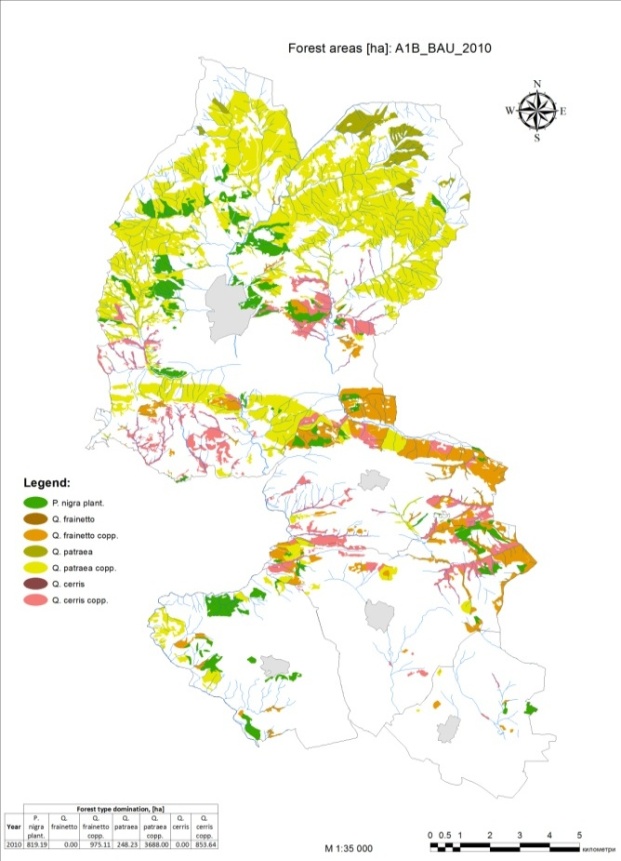
Fig BG-3. Species and origin dynamics of forest stands in the the case study Panagyurishte by moderate climate scenario A1B and BAU management (Year 2010).

Fig BG-4. Species and origin dynamics of forest stands in the the case study Panagyurishte by moderate climate scenario A1B and BAU management (Year 2100).
More of the pine stands should be harvested in mid-term run and pine will regenerate successfully together with some oaks. Looking long-term, about half of these future mixed stands will not be dominated by pine.
Flowering ash (Fraxinusornus) and Eastern hornbeam(Carpinusorientalis) will be more often a part of the tree species composition as provisional species.
For a summary of the tree species’ sensitivities please see Table BG-1.
Table BG-1: Mid- to longterm tree species’ sensitivities towards projected climate change for the three forest ecosystem processes. (+ increase, ~ no change, – decrease)
|
growth
|
regeneration
|
mortality
|
||||
| Tree species |
2020-2050 |
2050-2100 |
2020-2050 |
2050-2100 |
2020-2050 |
2050-2100 |
| Turkey oak –coppice |
~ |
— |
++ |
+ |
~ |
+ |
| Turkey oak – high |
– |
— |
~ |
– |
~ |
– |
| Sessile oak – coppice |
– |
— |
+ |
~ |
~ |
— |
| Sessile oak – high |
— |
— |
– |
— |
– |
— |
| Hungarian oak– coppice |
– |
— |
+ |
+ |
~ |
– |
| Hungarian oak– high |
– |
— |
~ |
— |
– |
— |
| Austrian pine |
– |
— |
~ |
+ |
~ |
— |
| Flowering ash |
~ |
– |
~ |
+ |
~ |
– |
Are the tree species in the forest sensitive to climate change? Wales (UK)
Climate change is expected to affect the growth and survival of forest trees through increased mean annual temperature and rainfall, while increasing the risks from storms, summer drought, pests and diseases. Towards the end of the century some variants of the A1B scenario indicate much drier conditions in the region. This would be expected to cause previously high yielding sites to be constrained by drought, so yield would drop. Tree species in these forests have different sensitivities to climate change with some expected to become more suitable and others expected to become less suitable (see species maps below). Pines and broadleaves can sustain their current output levels in the context of the drier A1B variants studied, while Spruce is only expected to do so where the climate projections suggest little or no decline in summer precipitation.
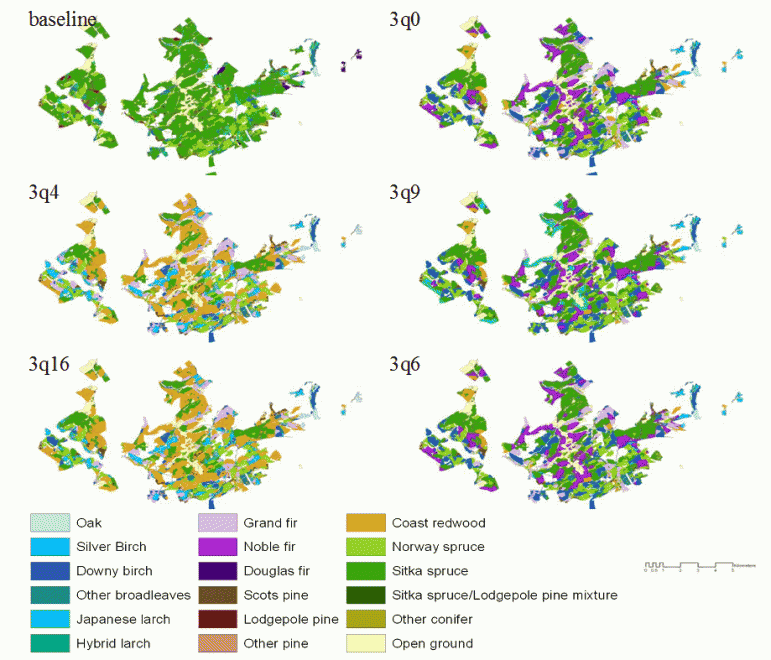
Fig. EN-1. Clocaenog species composition change by 2080 with Species Diversity storyline. Comparison of species composition between the baseline and five contrasting variants of the HadRM3 A1B 11 member ensemble. The maps on the left are for baseline and for variants with a warmer climate and reduced summer rainfall, and maps on the right show outcome for variants with warmer climate and little or no change to rainfall.
Are tree species in forest sensitive to climate change? North Karelia (Finland)
Growth
All the tree species in the case study area will physiologically (e.g. net primary production, NPP) benefit from warmer climate during the next 30 years as shown in Table JO-1 for Norway spruce (Climatic Zone II). The average annual NPP under CC is expected to be 5–15 % higher than that under current climate (CUR) until 2030 regardless of the climate zone. In the middle period, 2030– 2060, the average annual NPP under climate change (CC) will decrease again to the level of CUR in the Zones I and II, and further on below CUR during the period 2060–2099. The decrease rate of net primary production in the Zone I will be greater than that in Zone II. In the Zones III and IV, the average annual NPP under CC is higher than under CUR over the whole 100-year simulation period. In southern Finland, Scots pine on the medium-fertile site and birches on high-fertile sites become more preferable than Norway spruce.
Table JO-1. Periodic (2000–2030, 2030–2060 and 2060–2099) annual net primary production (NPP) of Norway spruce under the current (CUR) and changing climate (CC) in different climatic zones (I–IV) and site types (OMT and MT) over Finland. The values in parentheses are the percentage change (%) from that under the current climate. Climatic zones are separated based on the temperature sum (Ts): Zone I, Ts > 1200 d.d.; Zone II, Ts, 1000 -1200 d.d.; Zone III, Ts 750 – 1000 d.d.; Zone IV, Ts 600 – 750. The case study area is the representative of the climatic Zone II.
|
Climatic zone |
Site type |
NPP (Mg C ha–1 year–1) |
||||||||
|
2000–2030 |
|
2030–2060 |
|
2060–2099 |
||||||
|
CUR |
CC |
|
CUR |
CC |
|
CUR |
CC |
|||
|
|
OMT | 4.6 | 4.9 (5.2) | 4.9 | 4.9 (-0.8) | 4.4 | 3.9 (-12.7) | |||
|
I |
MT | 4.6 | 4.8 (4.4) | 5.4 | 5.4 (-0.7) | 4.6 | 4.0 (-13.9) | |||
|
|
Total | 4.6 | 4.8 (4.8) | 5.2 | 5.1 (-0.7) | 4.5 | 4.0 (-13.3) | |||
|
|
OMT | 4.2 | 4.5 (6.6) | 4.6 | 4.6 (-0.2) | 4.0 | 3.6 (-10.1) | |||
|
II |
MT | 4.3 | 4.6 (6.5) | 4.9 | 4.9 (-0.1) | 4.2 | 3.8 (-11.3) | |||
|
|
Total | 4.3 | 4.5 (6.6) | 4.7 | 4.7 (-.02) | 4.1 | 3.7 (-10.7) | |||
|
|
OMT | 3.7 | 4.0 (8.7) | 3.8 | 4.2 (10.1) | 3.9 | 4.6 (17.1) | |||
|
III |
MT | 3.4 | 3.6 (8.6) | 3.6 | 4.0 (8.8) | 3.4 | 4.0 (16.7) | |||
|
|
Total | 3.5 | 3.8 (8.6) | 3.7 | 4.1 (9.5) | 3.7 | 4.3 (17.0) | |||
|
|
OMT | – | – | – | – | – | – | |||
|
IV |
MT | 1.3 | 1.4 (12.6) | 1.3 | 1.6 (18.0) | 1.6 | 1.9 (23.8) | |||
|
|
Total | 1.3 | 1.4 (12.6) | 1.3 | 1.6 (18.0) | 1.6 | 1.9 (23.8) | |||
Regeneration
In the period 2000-2030, the success of natural regeneration of all tree species will be enhanced in the case study area due to the warming climate, which enhances flowering and maturing of seeds. Furthermore, the germination of seeds and establishment of seedlings will be improved. Also establishment of seedlings based on direct seeding (in Scots pine) and planting (in all species) will be improved. However, later on, natural regeneration (or direct seeding) may no more be that successful due to reduced soil moisture, which is likely to reduce the germination of seeds and establishment of seedlings. Low soil moisture on less fertile sites may also reduce the success of planting regardless of tree species.
Mortality
In the case study area, the changing climate may in general enhance tree mortality due to high wind speeds and/or heavy snow loading with shorter duration of soil frost from late autumn to early spring. In summer storms, especially Norway spruce but also Scots pine and birch (in leaf) are vulnerable to wind damage, whereas in winter time Norway spruce with shallow rooting is the most vulnerable (Figure JO-1). The mortality may also increase due to drought episodes and especially in Norway spruce with shallow rooting on sites with relatively low water-holding capacity. This has been found also nowadays in summers with exceptional high temperatures and long drought periods. Table JO-2 summarizes the sensitivity of growth, mortality and success of regeneration for different tree species to changing climate.
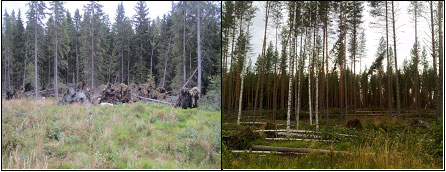
Figure JO-1. Under warming climate, the risk of wind damages in forests will increase regardless of any change in windiness.
Table JO-2. Mid- and long-term sensitivies of different tree species in the case study area. Legend: + increase, – reduction.
| Tree species | Growth | Mortality | Regeneration | |||
| 2020 -2050 | 2050-2100 | 2020 -2050 | 2050-2100 | 2020 -2050 | 2050-2100 | |
| Scots pine | +++ | ++ | + | + | +++ | ++ |
| Norway spruce | +++ | — | + | +++ | +++ | + |
| Birches | +++ | +++ | + | + | +++ | +++ |
Assume that current management (BAU) is continued: Is it possible to achieve current goals also under climate change conditions? North Karelia (Finland)
The main goal of management in the case study area is the sustainable and profitable use of the forest resources for all possible demands of society. This includes, in particular, the production of timber (for revenues), but also the maintenance of landscape beauty, attractive recreation environment including sustainable crops of berries and mushrooms, sequestration and storing carbon and providing habitats for wildlife. In short term (until the year 2020), a continuation of BAU will not affect the planned provisioning of ecosystem services (Table JO-3). In long term, the preference of Norway spruce on the sites of medium fertility (32% of forest area) or even on sites with lower fertility (44% of forest soils) due to moose problem in Scots pine and birch may reduce the capacity to produce timber and energy biomass, and sequestrate and store carbon in the ecosystem. This may also increase the risk of abiotic and biotic damages (e.g. bark beetle), which will further reduce the possibility to maintain the potentials to achieve the current goals under warming climate.
Table JO-3. Impacts of expected climate change on different forest ecosystem functions in the Finnish case study area. Legend: + positive impact, – negative impact, ~ indifferent.
| Forest ecosystem function | 2020 -2030 | 2050-2100 |
| Timber production | + | – |
| Carbon sequestration | + | – |
| Recreation values | + | ~ |
| Berries and mushrooms | + | ~ |
| Wildlife | + | ~ |
| Ground water | + | – |
| Landscape amenity | + | – |
Assume that current management (BAU) is continued: Is it possible to achieve current goals also under climate change conditions? South-East Veluwe (Netherlands)
Current management is in many cases already well adapted to the sites and climatic conditions, and already takes into account natural developments. A mild climate change scenario can be easily dealt with in the current management schedules and is not expected to lead to problems in relation to the goals set. Most forest functions are not much affected by the climate change scenarios. However, part of the current Natura2000-labelled old-growth oak and oak-beech sites would convert to coniferous forest under the more extreme climate scenario.
Assume that current management (BAU) is continued: Is it possible to achieve current goals also under climate change conditions? Prades (Spain)
In Poblet forest just like in most Mediterranean forests in southern Europe, BAU practices is no stand tending and a clearcut or a destruction by fire at variable age. Simulations show that the BAU management under climate change leads to a decrease in biomass production. The reason is that the high stand density of a BAU management in combination with increased drought stress leads to increased competition and mortality. The BAU leads also to a serious decrease in water use efficiency (table 1). This example shows the huge potential of management to keep ecosystem services on an aceptable level under climate change. These large differences in management outcome were also observed for other ecosystem services.
Table 1. water footprint (m3 of water/m3 of wood) in Pinus sylvestris.
|
Soil depth cm |
optimal management |
no management |
|
50 |
584 |
782 |
|
150 |
739 |
1263 |
Assume that current management (BAU) is continued: Is it possible to achieve current goals also under climate change conditions? Montafon Valley (Austria)
The formal overall goal of the forest holding SMF is the sustainable and profitable use of the forest resources for all possible demands of society. Operationally this includes the fulfillment of timber servitudes and the production of timber to create revenues, the maintenance of the protective services against gravitational hazards and the protection of the (cultural) habitat Montafon (biologically as well as socially).
Current management practices (business as usual; BAU) rely on long-distance cable yarding with skyline systems. The skyline tracks are set up diagonal along the slopes over distances of up to 1000m. Along the skyline tracks irregularly shaped slit and patch cuts are implemented in order to initiate and favour natural regeneration. Harvesting is done motor-manually, harvested trees are cut to length (4-6m logs) on site. The current management intensity (i.e. implemented skyline tracks per year) equals a virtual rotation length of 250 years (Figure MO-2).
In the short run (until the year 2020) a continuation of BAU management will not affect the planned provisioning of ecosystem services. However, due to the high share of Norway spruce in the forests of the Montafon timber production, as well as protection against gravitational hazards are likely to be negatively affected by intensified disturbance regimes, particularly from bark beetles. The long virtual rotation length and the focus on Norway spruce keep a high share of the forests in conditions of high susceptibility with regard to bark beetles. The need for salvage operations will increase in a warmer climate which in turn will negatively affect the planned harvest schedules and will subsequently increase the average harvesting costs per m3 timber. The intensified disturbance regime may also negatively impact on Carbon sequestration. However, due to a higher share of standing deadwood caused by bark beetle infestations the habitat and biodiversity functions for different vertebrate (e.g. woodpeckers) and invertebrate (e.g. longicorn beetles) species is expected to improve (Table MO-2).
Assume that current management (BAU) is continued: Is it possible to achieve current goals also under climate change conditions? Panagyurishte (Bulgaria)
The formal overall goal of the State forest enterprise “Panagyurishte” is the sustainable and profitable use of the forest resources for all possible demands of society. Operationally, this includes the fullfilment of fuel-wood demands and the production of timber to create revenues. The maintenance of the water catchments of the forest areas, the protective services against erosion, and the protection of the woody, and green landscapes of the slopes around the settlements and agricultural lands, is part of the present management aims and responsibilities of the local forest department.
The current management practices (business as usual; BAU) rely on the conception of converting existing coppice stands into high trough natural regeneration, which will increase the quality of producing timber and will ensure higher productivity in a long-term view.Since these stands are planned for seed regeneration, regular thinning is required until they reach maturity.Regeneration felling is shelter-wood implemented in two or three phases. Mandatory tending should be done after the final stage to suppress competition from new sprouts from the stumps of felled trees. If the latter tendings and thinings are not done (for example, because of lack of funds), then the future young stand will remain with a mixed origin and more sprouts will appear. Traditionally, the forests practitioners look at the man-made pine plantations as temporally stands which will produce some construction wood and after they reach rotation age of 60 to 80 years, will be partially or fully replaced by native trees (oaks, hornbeams).
The examination of the BAU scenario through the stand development modelling and simulation (PICUS model has been used) gives the following:
In short-term run all oak stands will not change vastly their silvicultural records. The pine plantation will be harvested more intensively, which will continue at some period after 2020 (fig. BG-7&BG-8).
Mid-term projections suggest an intensive timber harvest from the coppice stands, reaching double quantity of the present level (fig.BG-6). If this will not be done many uncertainties concerning future existence of all over-mature coppice stands will occur. The natural tree dyeback will be a precondition of fires or insect calamities.There will not be available timber from conifers (fig.BG-8). The average timber volume per hectare will considerably decrease .The trees’ cover will be more sparse and open, and individuals will be younger and smaller. Thus, some other ecosystem services as erosion protection and landscape improvement will become more vulnerable.
The long-term outlook is even worse .The stands will grow very slowly and both oaks and pine stands will be able to supply small amount of timber. The main goal to increase coppice transformation will not be reached. The area of the coppice stands remains the same as the current one (fig BG-5) and the main annual increment of the high oaks (fig.BG-9) keeps lower than the coppice ones (fig.BG-10), according to all climate scenarios.
The Carbon sequestration regime may also have a negative impact caused by a higher fire danger and the slow growth of the trees. However, due to a higher share of the standing deadwood caused by natural die-back and more open tree cover, the habitat and biodiversity functions for different mammal species (rodents, foxes, some wild boars) are expected to improve. On the other hand younger forests will not receive hospitality to endangered (late successional) species, which depend from old and heterogeneous forest stands (table BG-2).
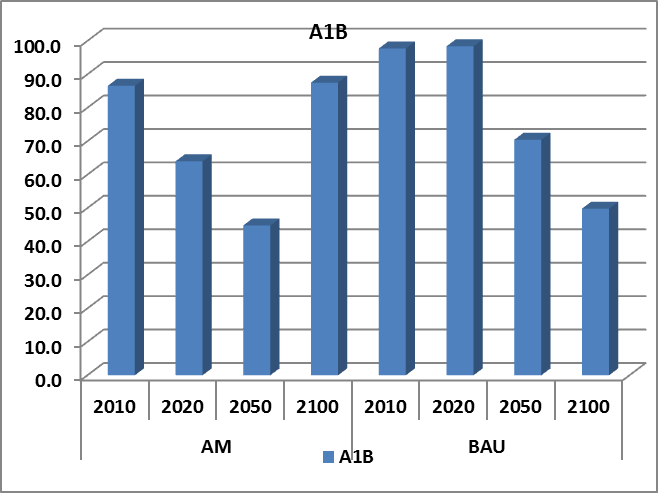
Fig BG-5. Current and projected average volume per ha of the coppice oak stands under moderate climate scenario A1B, AM and BAU management
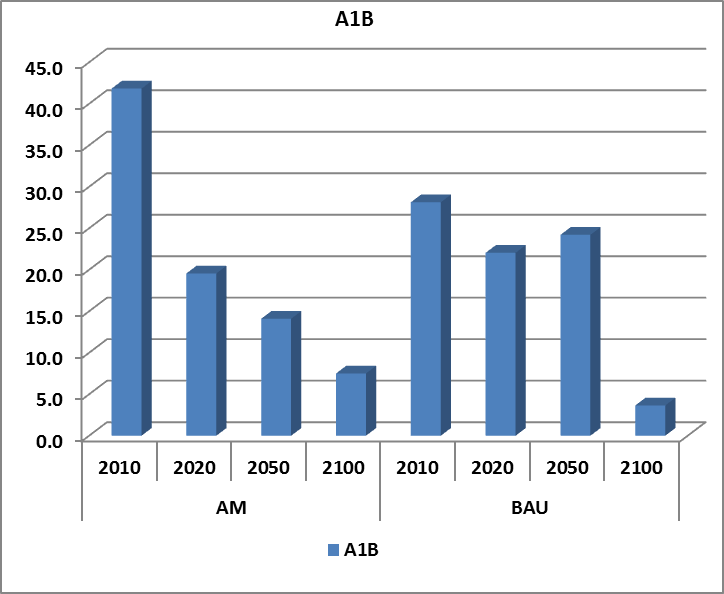
Fig.BG-6. Current and projected 10 years average removed timber volume per ha from the coppice oak stands under moderate climate scenario A1B, AM and BAU management.
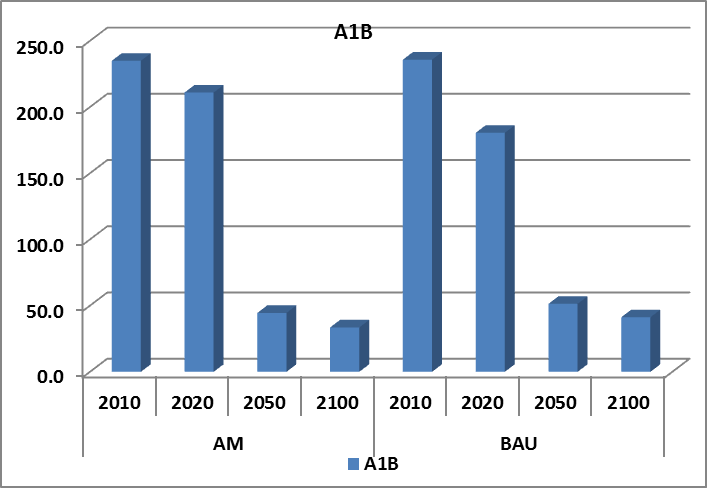
Fig.BG-7. Current and projected average volume per ha of the pine stands under moderate climate scenario A1B, AM and BAU management
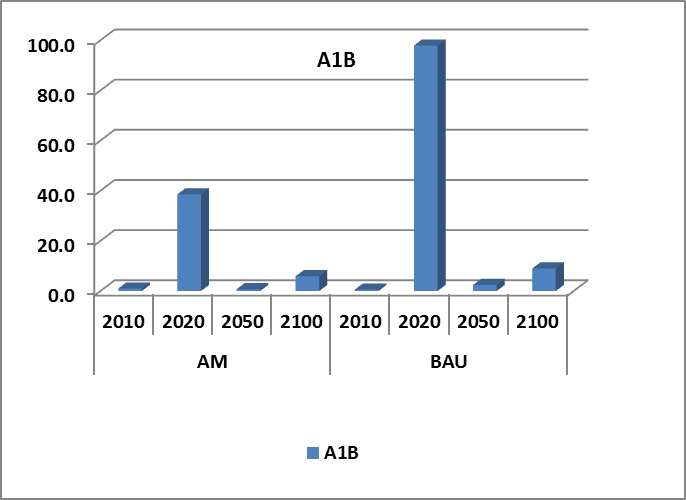
Fig.BG-8. Current and projected 10 years average removed timber volume per ha from the pine stands under moderate climate scenario A1B , AM and BAU management

Fig.BG-9. Average annual increment (cub.m/ha/year) simulation data for the high oak stands by climate scenarios (A1B, B1, BL) and BAU management scenario.
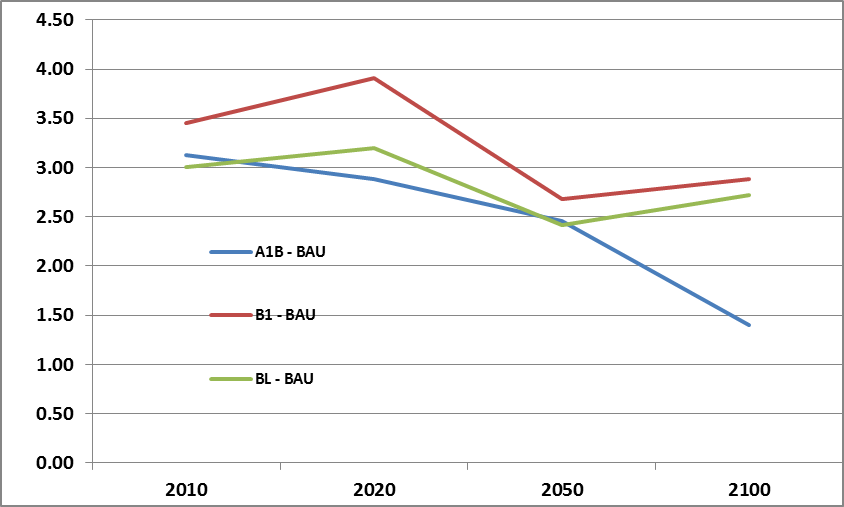
Fig BG-10. Average annual increment (cub.m/ha/year) simulation data for the copiice oak stands by climate scenarios (A1B, B1, BL) and BAU management scenario
Table BG-2. Impacts of expected climate change on different forest ecosystem functions in the Panagyurishte case-study (+ positive impacts, – negative impacts, ~ indifferent).
| Forest ecosystem function |
2020-2050 |
2050-2100 |
| Timber production and supply |
++ |
— |
| Protection of erosion |
~ |
–– |
| Landscape improving |
~ |
– |
| Carbon sequestration |
– |
— |
| Biodiversity |
~ |
– |
Assume that current management (BAU) is continued: Is it possible to achieve current goals also under climate change conditions? Carpathians (Romania)
The Frasin forest managers consider that stands are not particularly vulnerable to climate change. However some stands are more exposed to illegal logging, some other to forest fire, or other to grazing, which act as man-related disturbances able to amplify the negative effect of the climate change. Also, the uncertainty of the ownership created and will still create pressure on the forest management, e.g. attempt to harvest more than allowed.
The managers listed some additional risks that are related with the forest management practiced today. For example:
- the current management of the stands density: the stands are too dense;
- the production-oriented goals today do not meet anymore the economic demand or the ecological requirements: the stands are managed in long rotations and large tree sizes that is inducing a risk for unstable stands (too old) in the future, and are not satisfying neither the demand of the timber processing industry.
- The managers have started to have difficulties in regenerating the forests and in controlling the insects development, e.g. the bureaucracy of timber harvesting make impossible a fast intervention to cut infested trees and quickly stop insects development.
Thus, if there are not stands particularly vulnerable today, a combination between the current management risks and man-induced disturbances and the effect of the climate change may have serious consequences in the future. Then the natural drivers will make improbable the achievement of the current management goals. On the one hand, the economic difficulties encountered already today by the managers (they called the forestry practiced as being “subsistence forestry”) will increase with increasing disturbances, costs to fight attack insects and costs to regenerate the forests. On the other hand, the protective functions of the forests can not be achieved anymore if, for example, wind throw will happen on larger scale. The frequency and the quantity of timber extracted as salvage operations will increase and that will affect the planned harvest schedules. Nevertheless, the biodiversity is expected to increase following the different disturbances that are likely to occur (Table RO-1). Larger scale of windthrow will benefit to the regeneration of tree species that are now rare, e.g. birch, larch, horn bean, even oak, supplying then richer conditions for different animal species. In the BAU management, the biomass volume is quite similar to the current situation. The managers will have to face the reduction/disappearing of the Norway spruce and the apparition of pioneer species (Betula pendula, Salix) that will represent almost half of the biomass produced. Thus, due to the new species composition, there will be a significant decrease in the supply of wood for the market.
Table RO-1. Impact of the expected climate change on different forest ecosystem functions in Frasin forests (+ positive impact, — negative impact, * indifferent) for Business as usual 2100, ECHAM5 climate change scenario.
| Forest ecosystem functions |
2020-2050 |
2050-2100 |
| Timber production (allowed harvesting according to the Forest Management Plans) |
— (after the extraction of the old stands |
— (due to the new species composition, |
| Biodiversity |
+ |
+++ |
| Soil protection (if minor or no disturbances) |
+++ (better, due to the regeneration |
+++ (better, due to the regeneration |
| Soil protection (if large scale disturbances, e.g. windthrow, bark beetle infestation) |
— (worst than today, if regeneration do not happen |
— (worst, if regeneration do not |
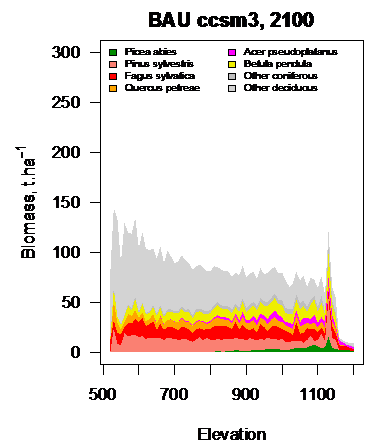
Figure RO-1. BAU management will lead to an decrease of the timber production, but an increase of the biodiversity
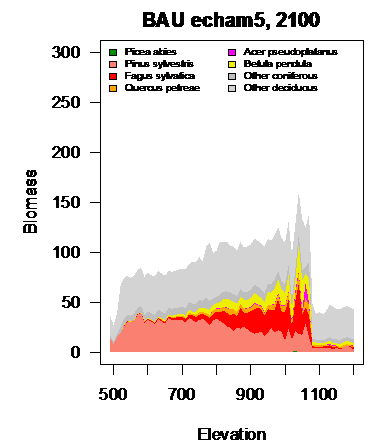
Figure RO-2. BAU management will lead to an decrease of the timber production, but an increase of the biodiversity
A particular problem comes from the age structure of the stands today in the Frasin forests (Figure RO-3). The current age class distribution is particularly unbalanced: at the beginning of the simulation (2000), half of the stands are more than 70 years old and a third more than 90 years. The excess of the over-mature stands will impose to the forest manager to progressively harvest the stands in order to distribute the harvesting of the old stands in tree-four decades. If climate change happen, the forest manager will not be able anymore to decide which stands to harvest, because he will be obliged to harvest according to the disturbances occurred. Current goals such regeneration after final cutting or spatial optimisation of cuttings for better soil protection may become impossible to achieve. The present old stands may remain un-harvested, therefore more vulnerable to new disturbances, also due to the accessibility of the stands, which is quite low (Figure RO-4).
Assume that current management (BAU) is continued: Is it possible to achieve current goals also under climate change conditions? Wales (UK)
Business as usual provides opportunities to achieve current goals under some future climate scenarios. However, Diversification as an adaptation strategy is expected to lead to less uncertainty, with projected standing biomass for all variants being between the highest and lowest projections for Business as Usual. Therefore although BAU has a possibility of higher returns, it also has a possibility of much lower returns than Diversification.
Studies of Business as Usual management assuming no climate change suggest that the current species choice is appropriate for conditions based on the period 1960-1990.
How can climate change uncertainty be considered in the analysis?
For a serious analysis it is not sufficient to use one “representative” climate change scenario. It should be standard approach to use a set of scenarios which should represent the range of expected changes in both, temperature and precipitation (and possibly also other climate variables). Particularly for preciptation the results of climate model projections do differ substantially and may include for the same region increases as well as decreases. The performance of BAU and alternative management options under such a set of climate change scenarios indicates how sensitive the delivery of ecosystem services may respond to interacting climate change and management. Management options which are very sensitive towards climate conditions are risky as long as there is high uncertainty regarding the future climate. In a soft but intuitive approach the key determinants are then (i) the importance of a particular ecosystem service, (ii) the opportunity to find a management approach which hedges against a wide range of possible future climates, and (iii) the cost of this “robustness” towards multiple climate futures.
How can I find a suitable forest simulation model to support the planning of adaptive forest management?
Key requirements for a forest simulation model suitable for adaptive forest management planning are: (1) sensitive to climate drivers, (2) sensitive to various kinds of forest management interventions, (3) considering key ecosystem processes from “first principles” (i.e. mimick the process instead of highly aggregated correlative relationships among system elements; so called process-based modelling approaches). For European forests there are a couple of such models available in a few research groups. Usually, such models are science tools and too complex so as that a lay user could readily use them. The models which had been used within the MOTIVE project are introduced in a Project Deliverable. It is recommended to contact the authors of a model which you may be interested in.
How did you come to your conclusion(s)? Which tools and methods did you employ? South-East Veluwe (Netherlands)
The landscape model LandClim is used to investigate large-scale effects of climate change on forest stand development and to develop and evaluate adaptive forest management strategies. The model was developed to assess the importance of climatic effects, wildfire and management on historical and future forest dynamics.
We simulated in total 9 scenarios (3 climate x 3 management scenarios). The forest was initialised with data from 1980. The period 1980-2010 was simulated with management as close as possible to real management, in consultation with stakeholders/owners/managers, and by applying observed weather over this period. All scenarios are simulated for the period 2010-2110.
How did you come to your conclusion(s)? Which tools and methods did you employ? Montafon Valley (Austria)
A key pillar of the recommendations for the Montafon was a scenario approach where “What happens, if (…)” questions were answered. Once these key questions had been defined together with the SMF management team the scenarios to be simulated were set up accordingly. All management scenarios extended until the year 2100 to capture the signals of management as well as climate change. The dynamic forest ecosystem model PICUS v1.5 was employed for the scenario simulations. All together 5 management variants were simulated under 2 transient climate change scenarios and under current climatic conditions. A set of indicators representing the demanded ecosystem services (an example is given in the table below) was fed by model output and subsequently used to analyze the interrelationships of initial forest state, management concept including assumptions about game management intensity and climate conditions. Three time horizons were defined to better communicate the temporal implications of the scenarios (2020, 2050, 2100). To account for stakeholder preferences in evaluating the scenarios multi-criteria analysis techniques have been used.
| Indicator |
Unit |
Threshold minimal |
Threshold ideal |
Constraints |
| Gap size |
[m²] |
600 m² |
400 m² |
no regeneration, trees ≥ pole stage |
|
1200 m² |
800 m² |
with existing regeneration, trees ≥ pole stage |
||
| Crown cover |
[%] |
≥ 40 % |
≥ 60 % |
trees ≥ pole stage |
To better communicate the potential implications of scenarios to forest managers and stakeholders, landscape level visualization of forest development (Figure MO-6 and Figure MO-7), forest ecosystem service provisioning (Figure MO-8) have been used.
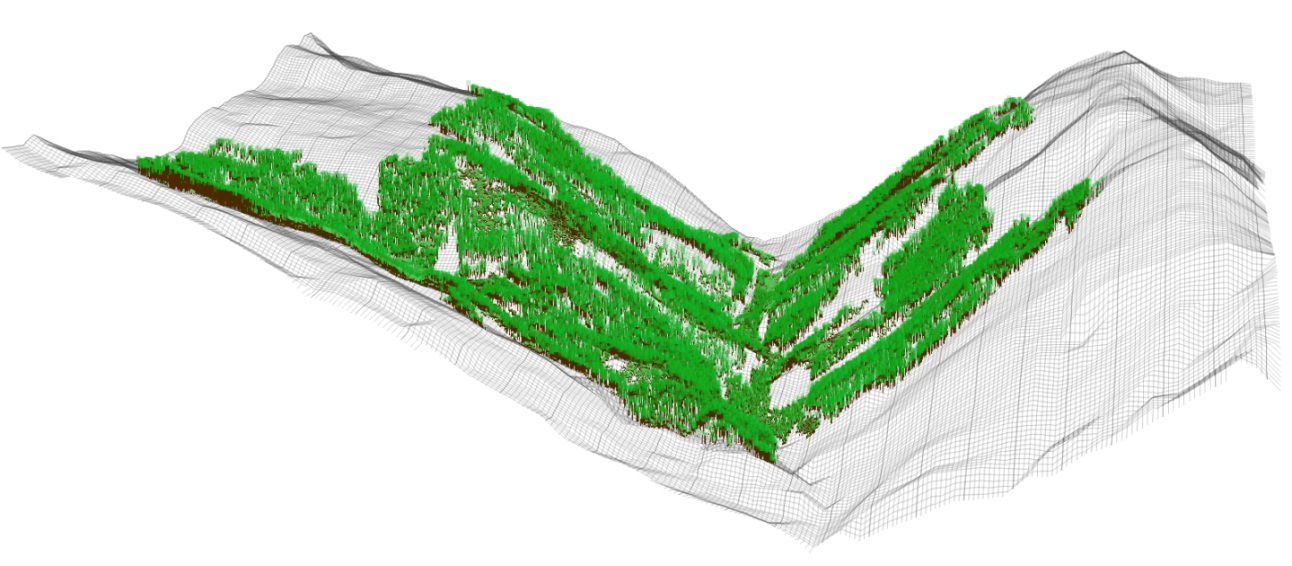
Figure MO-6: Landscape level visualization of 215 ha of forests embedded in a framework of non-stockable gullies and avalanche tracks in the Rellstal valley, Montafon. This small side valley features one south- (right) and one north-facing slope (left). They extend from 1160 m a.s.l. at the valley bottom to the actual timberline at around 1800 m a.s.l.
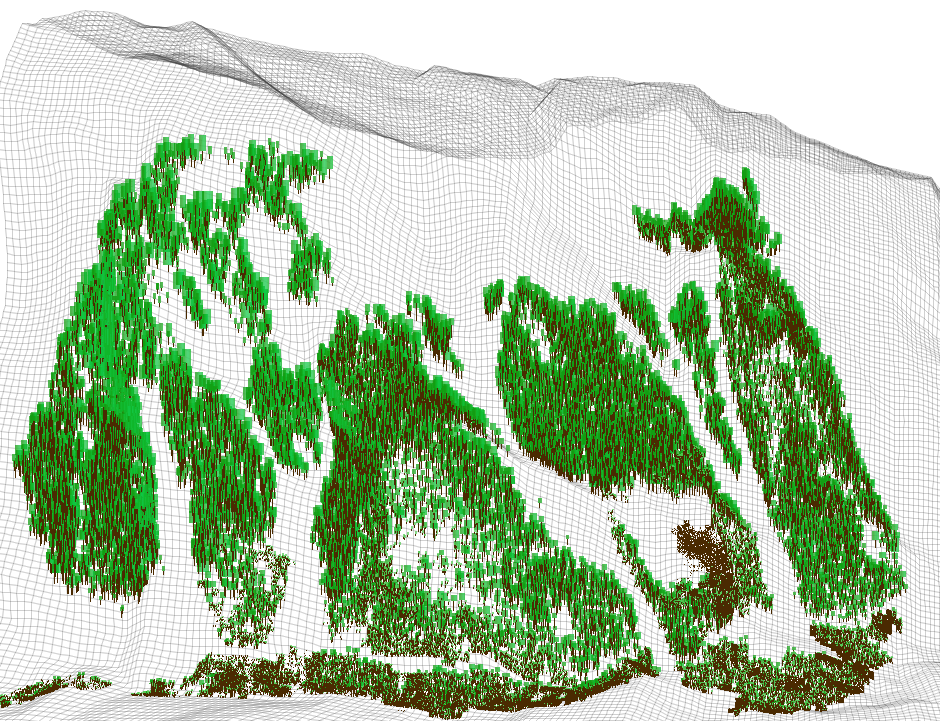
Figure MO-7: A more detailed visualization of ca. 70 ha forests of the south facing slope in the Rellstal valley in the Montafon. Meso-scale forest structure and distribution pattern is highlighted.
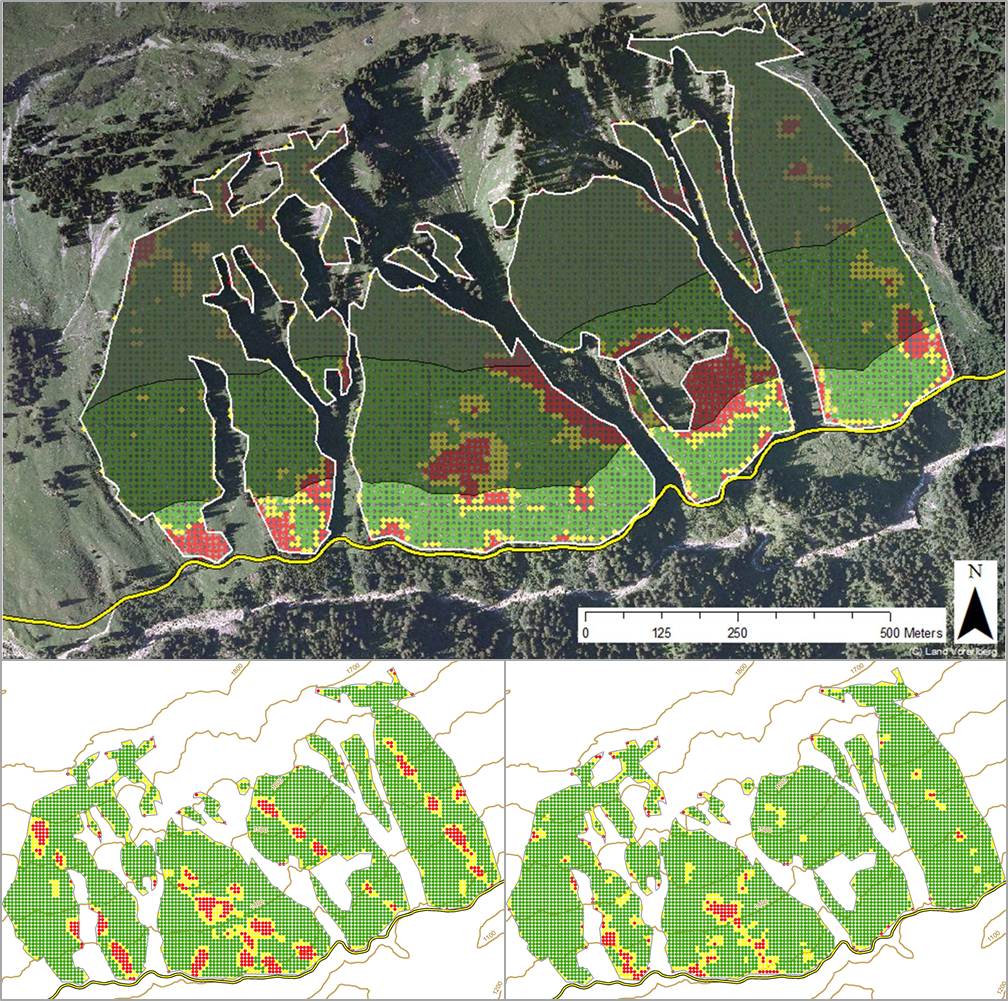
Figure MO-8: Visualization of the protection efficiency against landslides for the current forest conditions (year 2010, on top). The road (displayed at the bottom of the map; yellow line) is the object to be protected. The white lines delineate the analysis area. The results of the assessment are presented as colored pixels (a) green (optimal requirements met), (b) yellow (minimal requirements met) and (c) red (requirements not met). The shading of the map increases with distance from the road (300 m dark grey shading). Bottom left hand side: the protection against landslides for the current management under climate change in the year 2100 is shown. Bottom right hand side: results for the recommended management under climate change in the year 2100.
How did you come to your conclusion(s)? Which tools and methods did you employ? Prades (Spain)
In order to support the development of optimized adaptive forest management scenarios for the Poblet area, a new forest management decision support tool was constructed. This system integrates the dynamic forest simulation model GOTILWA+, based on physiological processes controlled by climatic and edaphic factors and able to predict forest development under different climate scenarios and management options with a Particle Swarm optimization algorithm that supports in rapidly finding the optimal combination of decision variables (the number, timing and intensity of thinning and the rotation length) to maximise a given management objective under a certain climate – management scenario. Two climate scenarios were applied: current climate and Climate Change (A1FI scenario, IPCC) using daily climate data. Three different management objectives have been tested: (1) timber profitability (soil expectation value, SEV) (€/ha), (2) wood biomass production (WBP) (Mg/ha/year), (3) stand-level water use (WU) (m3 of water/m3 wood produced) and a fourth objective, crucial for the management of Mediterranean forests, a composite index of Fire risk and Damage. The decision variables (i.e. the variables to optimize) are the time between thinnings and the basal area remaining in the forest after each particular thinning (as a measure of the thinning intensity). The age at which the last thinning takes place defines the rotation length. Other variables such as the time of the tending or preparatory thinning, the remaining density of trees after tending, the threshold for DBH size of these remaining trees, as well as the threshold size of the trees cut during the commercial thinning have been kept as constant values. Further exploration of the effect of the changing values of these variables on the final optimized results is to be explored in future steps. The results mentioned in these pages have been obtained with a constant density of 1200 trees/ha after tending with DBH >= 7 cm. The tending has been always applied at the age of 12 years. When the density of trees with a DBH >=7 cm at age 12 is lower than 1200 trees/ha, the remaining density is reduced to this density in order to keep trees with a DBH >= 7 cm. Analogously, at each commercial thinning intervention, all the trees cut have to be trees equal or bigger than 10 cm in DBH. This is a main commercial restriction which has important effects on the final results. An important effort was also undertaken to construct user-friendly interfaces that facilitate the selection of climate scenarios, management objectives, site variables, economic parameters, etc. to the user. These interfaces also provide visual and summarized information on the optimal forest management strategies for the selected variables. It has become a user friendly but rather complex tool integrating in a unique way a mechanistic model and a management optimization algorithm. We do not expect this tool to be used by field managers, but it is an interesting tool for scientific analysis, advanced forestry and ecology students, or consultants preparing forest management plans.
The outcomes of the decision support system were confronted with expert knowledge of the field managers, and with experiences and published results from decades of climate change related research in Poblet area, conducted by CREAF, UB and other institutes. Conversion experiments in holm oak coppice towards high forest showed for example that thinning improves vitality and growth under drought stress.
Some related papers:
Lopez B., Gracia C.,Sabate S. and Keenan T. 2009. Assessing the resilience of Mediterranean holm oaks to disturbances using selective thinning. Acta Oecologica, 35 pp:849-854
Keenan T., Niinemets U., Sabaté S., Gracia C., Peñuelas J. 2009. Seasonality of monoterpene emission potentials in Quercus ilex and Pinus pinea: Implications for regional voc emission modeling. Journal of Geophysical Resarch, 114. 11 pp.
Keenan T., Sabaté S., Gracia C. 2009. The importance of mesophyll conductance in regulating forest ecosystem productivity during drought periods. Global Change Biology. 16 pp.
Cotillas M., Sabaté S., Gracia C., Espelta J. 2009. Growth response of mixed mediterranean oak coppices to rainfall reduction. Could selective thinning have any influence on it? Forest Ecology and Management, 258. 1677-1683.
GRACIA C. 2008. Water yield depends on the water and carbon trade-off in forest ecosystems. EXPO-World Zaragoza.
López B., Holmgren M., Sabate S., Gracia C. 2008. Estimating annual rainfall threshold for estabalishment of tree species in water-limited ecosystems using tree-ring data. Journal of Arid Environments, 72. 602-611.
GRACIA C., SABATE S, Keenan T., 2007 Carbon pools in Mediterranean forests: comparing eddy covariance and GOTILWA+ model results. At Carbon dynamics in natural beech forests, Slovenian Forestry Institute (SFI), Ljubljana, Slovenia.
Schröter D., Cramer W., Leemans R., Prentice I.C., Araujo M., Arnell N., Bondeau A., Bugmann H., Carter T., Gracia C., Vega-Leinert A.d.l., Erhard M., Ewert F., Glendining M., House J., Kankaanpaä S., Klein R., Lavorel S., Lindner M., Metzger M., Meyer J., Mitchell T., Reginster I., Rounsevell M., Sabate S., Sitch S., Smith B., Smith J., Smith P., Sykes M., Thonicke K., Thuiller W., Tuck G., Zahele S., Zierl B. 2005. Ecosystem service supply and vulnerability to global change in Europe. Science, . 10 pp.
Morales P., Sykes M.T., Prentice I., Smith P., Smith B., Bugmanns H., Zierl B., friedlingstein P., Viovy N., Sabate S., Sánchez A., Pla E., Gracia C., Sitch S., Arneth A., Ogee J. 2005. Comparing and evaluating process-based ecosystem model predictions of carbon and water fluxes in major European forest biomes. Global Change Biology, 11. 2211-2233.
Gracia C., Pla E., Sánchez A., Sabaté S. 2004. Gotilwa+: Un modelo de crecimiento forestal basado en procesos ecofisiológicos. Cuad. Soc. Esp. Cienc. For., ?
Sabaté S., Gracia C., Pla E., Sánchez A., Vayreda J. 2004. Aplicación del modelo GOTILWA+ al análisis de los efectos del cambio climático y la gestión forestal en el balance de carbono y agua en los bosques. Cuad. Soc. Esp. Cienc. For.
How did you come to your conclusion(s)? Which tools and methods did you employ? Panagyurishte (Bulgaria)
The scenarios and recommendation for the Panagyurishte case-study area are defined on the basis of expert opinions of the foresters involved in different management levels, as well as the present legal framework and stakeholder preferences.
The dynamic forest ecosystem model PICUS v1.5 has been employed for the scenario simulations. An additional new module for simulation the stumps sprouting after felling has been developed. A set of indicators representing the demanded ecosystem services (an examples are given in Tables 1 and 3) was fed by model output and subsequently used to analyse the interrelationships of initial forest state, management concepts including assumptions about management intensity and climate conditions.
How did you come to your conclusion(s)? Which tools and methods did you employ? Carpathians (Romania)
Landscape level model LandClim was used to simulate forest ecosystem dynamic. Adaptative management were explored using the harvest module by defining potential management scenarios for each management unit within the forest district studied following the silvicultural trends. The simulations was run on the forest district landscapes designed from a digital elevation model, stand and soil information, climate data and forest ownership maps.
The data from the management plans produced before 1989 were used to initialize the private stands. A first run enabled to simulate the current starting state of these stands, after they had been aged for 2 decades by the model.
The model did not deal specifically with the uncertainties.
How did you come to your conclusion(s)? Which tools and methods did you employ? Wales (UK)
A suite of decision support tools and models were used to examine case study outcomes to 2080 based on differing management strategies: Business as Usual, Species Diversification, Short-rotation forestry and Low-impact silvicultural systems (LISS) that is essentially conversion to continuous cover.
Management strategies
- Business as usual (BAU). This was the ‘Conservative’ trajectory (see D4.4), replacing forest stands ‘like for like’ with the same species and maintaining forest management alternatives as they are over the simulation period.
- Species Diversification (DIVERSE). This followed a ‘Progressive’ trajectory for species mix. Species suitability was modelled at each 10-year period and species were changed at scheduled interventions (usually clearfell, replant) to maximize species diversification whilst also maximizing production. Other species diversification rules from the Welsh policy guidance document “Species Diversification” were used to accelerate diversification where possible, but these also restricted diversification in places due to the need to maintain populations of some species such as Scots pine and Norway spruce for other objectives. When a stand is restocked, ESC selects a replacement species based on highest yielding suitable species.
- Transformation to a Low Impact Silvicultural System (LISS). This followed a ‘Progressive’ trajectory aspiration for FMA change. It applied continuous cover forestry (CCF) as widely as possible, constrained by wind exposure to lower elevation sites. In practice this would be further constrained by operational considerations.
- Conversion to short rotation forestry for biomass production (SRF). Stands reaching the end of their FMA4 management were subsequently replanted with the same species on a 25 year rotation. Norway Spruce and Scots Pine in those areas would be retained on 100 year rotations to support habitats for rare species (e.g. red squirrels).
Models
These were run with data from five variants of the HadRM3 A1B climate model. The models run were a species suitability model (Ecological Site Classification, ‘ESC’), growth and yield models (various); assortment models (ASORT, BSORT, CSORT); wind risk model (ForestGALES). The method for each management strategy and climate model variant was as follows, for each decadal time period and with each climate scenario:
- Use growth models to grow each stand
- Assess which stands to fell based on whether they have reached their rotation length for given management regime.
- Thin remaining stands as appropriate
- Perform log and biomass assortments on thinnings and fellings
- For each felled stand, decide which species and management system to replace it with (under Diversification storyline)
- Update database with changes and repeat process.
Outputs
Models provided outputs as a range of ecosystem service indicators, including: Timber outturn volume; Standing Carbon; Recreation index; Biodiversity index and Wind damage risk status. The ESC suitability score gave a measure of the suitability of the species for a given site under prevailing climatic/soil conditions at a particular time.
How did you make your conclusion(s)? Which tools and methods did you employ? North Karelia (Finland)
The conclusions are mainly based on ecosystem model based analyses carried out in Finnish conditions. In these studies, the basic question has been: how is the climate change affecting the dynamics of managed boreal forest ecosystems and the consequent growth and development of managed boreal forests, and how the boreal forests should be managed under the climate change in order to sustain the production of goods and services obtainable in forest management. The main focus in these studies has been on the production of timber and biomass for energy and the sequestration and storing carbon in the forest ecosystem. However, also previous experimental studies on the climate change impacts (e.g. elevated CO2, temperature, availability of water and nitrogen) have provided data for modeling, which utilized the basic physiological mechanisms to introduce the climate change impacts into the dynamics of the forest ecosystems. On the other hand, some of these models (e.g. FinnFor/Sima models) include also the effects of management (e.g. regeneration, tending of seedling stands, thinning, rotation length, nitrogen fertilization, provenance effects on growth) on the structure and the consequent dynamics of the forest ecosystem. Large-scale and multiple applications of the models in scenario analyses and the analyses of the current functioning and structure of forests throughout Finland have given a comprehensive insight on how the managed boreal forests may growth and develop under changing climate change and how these changes should be considered in formulating management rule to fit the situation due the changing climate. The findings have been widely discussed also in seminars with other researches, forest practitioners, administrators and policy-makers. In this context, the future management options are scaled to meet the needs and possibilities set by economy, forest policy, legislation and perception among public.
How did you make your conclusion(s)? Which tools and methods did you employ? Kronoberg (Sweden)
Our results are based on simulations of forest development with the Forest Time Machine (FTM) model and assessments of wind damage probabilities for the projected forest states using the WINDA-GALES model.
The FTM model is a forest management-unit simulator developed to support evaluation of forest management strategies at a landscape level (Andersson et al. 2005). The model uses empirical stand growth functions and different stand management programs can be assigned to the individual stands. The stand growth response to climate change is mediated by adjusting the site index according to modeling results from the FinnFor model (Kellomäki & Väisänen 1997; Matala et al. 2005). FTM outputs variables describing periodical states of the forest as well as flows of harvested wood and money.
In our FTM simulations we have applied stand management programs reflecting today’s management in terms of choice of tree species, initial spacing, thinning regime and rotation periods (business as usual management). We have applied adaptive stand management programs including shorter rotation periods and adjusted thinning regimes in combination with a species change at wind exposed locations. At these locations conifer tree species have been replaced with Silver and Downy Birch using natural regeneration at first regeneration occasion. The use of other deciduous tree species is expected to require additional game management and/or use of fencing at regeneration to mitigate browsing by moose and deer.
The WINDA-GALES model is an integrated system of models for assessing the probability of wind damage to forest stands building on the WINDA model (Blennow & Sallnäs 2004) and the GALES model (Gardiner et al. 2000). It provides a geographically explicit environment for standwise calculation of the probability of exceeding critical windspeeds for wind damage in a landscape. The calculations are sensitive to the stability of the forest as well as to the local wind climate and uses extreme value theory for the statistical calculations.
Gardiner, B.A., Peltola, H., Kellomäki, S., 2000. The development and testing of two models to predict the critical wind speeds required to damage coniferous trees. Ecol. Model. 129, 1–23.
Kellomäki, S. and Väisänen, H. 1997. Modelling the dynamics of the boreal forest ecosystems for climate change studies in the boreal conditions. Ecological Modelling 97: 121-140.
Matala, J., Ojansuu, R., Peltola, H., Sievänen, R. and Kellomäki, S. 2005. Introducing effects of temperature and CO2 elevation on tree growth into a statistical growth and yield model. Ecological Modelling 181:173-190.
How do you incorporate uncertainties in your recommendation? North Karelia (Finland)
Uncertainties are assessed by applying various climatic scenarios in order to find how the climate related uncertainties may affect the findings and conclusions. Some of the models include also stochastic processes of growth and mortality etc, to consider the uncertainties related to predictions. Regarding the risks due to wind and snow load, comprehensive assessments have also been done based on weather statistics to identify how frequent detrimental wind velocities and snow loads are and how they are expected to change due to the climate change.
How do you incorporate uncertainties in your recommendations? Montafon Valley (Austria)
The general approach to handle uncertainties has been a cooperative decision with the local managers of the SMF. We decided not to feature a formal uncertainty analysis but we clearly try to separate different sources of uncertainty: climate change scenario uncertainty, knowledge gaps about tree species vulnerability, as well as uncertainty about the future disturbance regimes in communicating the results of the analysis to the stakeholders.
A scenario approach has been taken to derive recommendations for the Montafon case study. From a precautionary perspective the most severe climate change scenario available (story line A1B) has been used to derive the recommendations.
In estimating the future establishment success of silver fir, European larch or broadleaved species a conservative approach has been taken in the forest ecosystem simulations and in the interpretation of results. A certain level of browsing pressure on these tree species has been taken into account even in the management scenarios featuring a more intense game management.
How do you incorporate uncertainties in your recommendations? South-East Veluwe (Netherlands)
In the final report about the case study, and in other dissemination material, we stress that these are the outcomes of model simulations and not predictions about future reality. We also stress that the climate scenarios are the most extreme from the current range and reality might be somewhere in the middle, or even beyond this range. In general, the managers involved understood really well the limitations of the approach, and how they should approach the results. They even explicitly asked about the uncertainties.
How should we identify the need to adapt?
The baseline analysis we need to undertake is always to judge, how current management (Business as usual; BAU) performs under conditions of climate change. As the future climate is highly uncertain, a set of climate change scenarios should be used for this analysis. Important features to look at are: (i) What are the impacts of climate change scenarios on defined ecosystem service indicators? If the deviance of BAU under current climate and BAU under potential future climate is huge the need to adapt is obvious (assuming that sustainable fulfillment of ecoystem service demands by society is the general management objective). (2) Are there any alternatives which perform better than BAU? Is it worthwhile to continue with the same objectives in case BAU and available alternatives can not deliver the required ecosystem service outputs?
Is a standard forest inventory suitable as monitoring tool for adaptive management?
Typcally a standard forest inventory is based on a statistical sample from the forest area of a forest management unit. The selection can be based on a regular grid of a specific mesh size or any other objective method. A standard remeasurement period in temperate high forests is 10 years. Although forest inventories are inevitable for sustainable forest management standard inventories may not be perfectly suited to monitor adaptive management. The core idea of adaptive management is that periodically it is evaluated whether the implemented management activities perform as expected. For this purpose the effect of management must be isolated from other factors which may affect forest development (e.g. elapse of time, disturbances, climate change, etc.). This requires usually some „baseline“ variant which must be comparable otherwise with the forest area where a particular adaptive measure has been implemented. Sampling method and sampling percentage (i.e. how many samples, which share of the area) depend on the effects that should be detected.
What it the uncertainty of the outcome? Prades (Spain)
In modelling exercises there are different sources of uncertainty, including data uncertainty, model uncertainty, and scenario uncertainty. For the model predictions of Scots pine development under climate change in the Prades area using the Gotilwa+ model a sensitivity analysis was performed on the input variables of the model, more particularly on model parameters related to photosynthesis, stomatal condition, and on input variables related to thermal inertia, tree structure and soil. Each tested variable was increased and decreased with 20% of its initial value, and the effect after a modeling period of 50 and 100 years was evaluated for the output variables aboveground biomass (t/ha), basal area (m2/ha), GPP (t.ha-1.year-1), NPP (t.ha-1.year-1), WUE (mmol/mol), transpiration (mm/year), autotrophic respiration (t.ha-1.year-1), and heterotrophic respiration (t.ha-1.year-1).
Concerning sensitivity to photosynthesis parameters, all output variables in particular biomass, GPP, NPP, WUE, and respiration were sensitive to changes in the maximum rate of electron transport Jmax, while not any of the output variables appeared sensitive for changes in maximum rate of carboxylation VCmax. This might be because VCmax is not light limited in the Mediterranean area, in contrast to other more northern latitudes. Concerning sensitivity to parameters determining stomatal conductance, all variables, particularly biomass and WUE were sensitive to changes in the constant of Leuning LEC, and only little sensitive to other parameters. Concerning sensitivity to temperature variables most output variables were very sensitive to maximum temperature, less to minimum temperature, and little or not to thermal inertia. As to the sensitivity to tree structure variables and allometrics, the output variables are most sensitive for changes in the respiring fraction of sapwood and for the amount of mobile carbon. As to the soil variables, the output is mainly sensitive for field capacity and soil depth.
Which adaptive measures appear as suitable response to the changing climate in order to sustain the provision of demanded ecosystem services? What is the recommendation to the forest management? North Karelia (Finland)
Table JO-4 summarizes some approaches available to adapt to the changing climate in short and long term. The case study area is located in the mid-boreal zone, where the warming is generally increasing the forest growth, if the availability of water is not reduced too much due to enhanced evaporation. In any case the changing climate is clearly increasing the frequency and duration of drought episodes, which occur even under the current conditions. Drought risk is likely reduced in northern boreal (and partly mid-boreal boreal) forests, but increased in southern boreal (and partly mid-boreal) forests, including the case study area.
In general, existing tree species (either native or exotic) are probably growing faster, with more rapid life cycle and enhanced turnover of tree populations. However, later in this century, the use of Norway spruce should be preferred only on the fertile and moist sites in order to avoid the likely reduction of growth and increase of drought caused mortality and damages due to bark beetles. The consequent reduction of area occupied by Norway spruce will reduce the wind-induced damages in winter. However, in summer time all tree species may suffer equally summer storms. Any increase in breeding material will increase the risk of damages due to bark beetle, due to a rapid growth of bark beetle populations (if not harvesting timber soon enough).
Regarding regeneration, the preference of coniferous species in planting may require careful site specific choice of tree provenance and species with more optimal response to the changing climate (Table JO-4). This seems to allow more southern and more productive provenances of Scots pine and Norway spruce to be used in forestry. However, the properties of photoperiod may limit the provenance transfers northwards to be less than 200 km even in short term. In long term, the tree improvement programmes may be launched in order to increase the genetic potentials of tree plantations to adapt to higher temperatures with low risk to be damaged by spring and autumn frosts. However, the preference of natural regeneration, and especially in Scots pine on less fertile sites (44% of forest soils in case study area), provides huge genetic potentials to adapt forest to the climate change in the region represented by the case study area. This choice is realistic, since natural regeneration is a common practise in forestry along with direct seeding in Scots pine.
Table JO-4. Outlines of the adaptive management for the boreal forests in Finland. Adopted and modified from Kellomäki and Leinonen (2005).
|
Changes in climate, with impacts on site properties |
Sensitivity and vulnerability |
|
|
|
|
|
Short term (2000 – 2050) |
Long term (2050 -2100) |
|
Management planning |
|
|
|
Gene management |
|
|
|
Forest protection |
|
|
|
Silvicultural management |
|
|
|
Technology and infrastructure |
|
|
Natural deciduous regrowth in coniferous plantations may require more tending of seedling stands in favour of coniferous species (Table JO-4). Later, more frequent and/or intensive thinnings may be needed to maintain the growth of trees and reduce risks of abiotic and biotic damages. The regular thinnings will also increase the stability of trees due to the enhanced radial growth, and thus reduce the risk of abiotic damages. Regular thinnings and shorter rotations are also needed to avoid biotic damages (e.g. due to lower growth rate of maturing trees and drought episodes), however, the need depending on the subarea of boreal zone and site fertility. Regular thinnings reduce the evaporation, thus increase soil moisture and reduce the risk of drought on the areas and soils, where the summer-time evaporation is likely to exceed the summer-time precipitation. In this regard, regular thinnings of Norway spruce stands may reduce substantially the effects of drought on growth and mortality.
Which adaptive measures appear as suitable response to the changing climate in order to sustain the provision of demanded ecosystem services? What is the recommendation to the forest manager? South-East Veluwe (Netherlands)
We have analysed three management scenarios. Business as usual is a continuation of the current management. Intensified management (IM) anticipates at increased productivity of the forest due to climate change by intensifying the management. In IM, in some reserves wood harvest is resumed, while some heathlands are allowed to convert naturally to forest. Thinnings are aimed at increasing production of remaining trees or to stimulate regeneration of more productive/economically attractive species, sometimes assisted by planting. Precautinary management (PM) aims at decreasing risks associated with climate change. PM is more careful than IM, with more small-scale thinnings and more care to maintain tree cover. In PM managers influence tree species distribution to decrease vulnerability. Some choose for Castanea sativa and Tilia cordata, sometimes in combination with oak, beech and birch. Other managers stimulate Scots pine and Douglas fir. All management scenarios were discussed with the managers, and the adaptive scenarios thus differ in implementation and risks/chances that are dealt with.
In general, both IM and PM have a tendency to negatively influence the forest services and risk level, although at different rates under different climate scenarios. Some trade-offs are visible, for example PM negatively affects biodiversity in the area, but has a positive effect on the standing stock and increment. IM has a smaller negative impact on biodiversity goals, but is decreasing production indicators. Overall, continuing the current management seems the best option to maintain the current levels of service provisioning. Early and strong changes in management strategy as response to an expected extreme climate change might lead to irreversible losses of especially biodiversity values if climate is less extreme as expected. However, only in another 50 years starts the W+ scenario to be really different from the G scenario, which gives ample time to adapt management to observed climate change as time progresses.
Continuation of current management is therefore the best choice for the time being, but it is recommended to monitor the forest development and the climate closely in order to be able to adapt the management if necessary. However, individual owners may decide differently for their own properties, based on different preferences.
Which adaptive measures appear as suitable response to the changing climate in order to sustain the provision of demanded ecosystem services? What is the recommendation to the forest manager? Montafon Valley (Austria)
There are several options available to adapt forest management in the Montafon to a changing climate. Based on the currently high share of Norway spruce broaden species composition towards a more diverse set of less vulnerable species will be a long-term objective. Silver fir, European larch and broadleaved species such as sycamore maple and European beech could be promoted as admixed species.
Silver fir is less favoured as timber species but performs at least as well as Norway spruce for protective functions. It may itself be subject to higher risk from bark beetle infestations in the future. Broadleaved species will positively affect biodiversity, but will not directly support timber production goals as these species in the current management frame will mainly produce low quality logs and fuelwood. For rockfall and avalanche protection broadleaves are considered less effective compared to winter green conifers.
European larch could be promoted as a valuable timber species, too, however due to its current absence in the Montafon the promotion of larch will rely on artificial regeneration. For the other species seed trees for natural regeneration should be available in sufficient abundance. However, any attempt to promote other species than Norway spruce will require improved game management approaches. The densities of ungulate game species such as roe deer (Capreolus capreolus), red deer (Cervus elaphus) and chamois (Rupicapra rupicapra) are currently at high levels causing severe browsing pressure on tree species susceptible to browsing (Silver fir, sycamore maple and European beech). This favors Norway spruce and is a strong limitation to any successful establishment of species mixture. The counter measures will have to include a reduction of the deer populations and changes in the hunting strategy towards intensified hunting where regeneration needs to take place and reduced disturbance by hunters and other nature users, like hikers or backcountry skiers. It is important to note that all actions aiming at changing the actual tree species composition will require significant time-lags.
Analysis has clearly shown that continuation of BAU results in increasing timber stocks which in turn increases susceptibility to bark beetle infestations and may also increase damage levels. Clumped tree mortality will in turn negatively affect the protection effect against gravitational hazards. As adaptive measure to mitigate these effects it is recommended to increase the annual cutting area by increasing the number of skyline tracks. At the same time the cutting pattern along the tracks should be modified. To keep gaps in slope direction as small as possible to prevent e.g. falling rocks from gaining too much speed a horizontal slit cut approach is recommended. Overall, this will reduce the cutting area per skyline but in combination with more skylines per year increase total annual cutting area (compare Figures MO-3 for BAU and Figure MO-4 for recommended management).
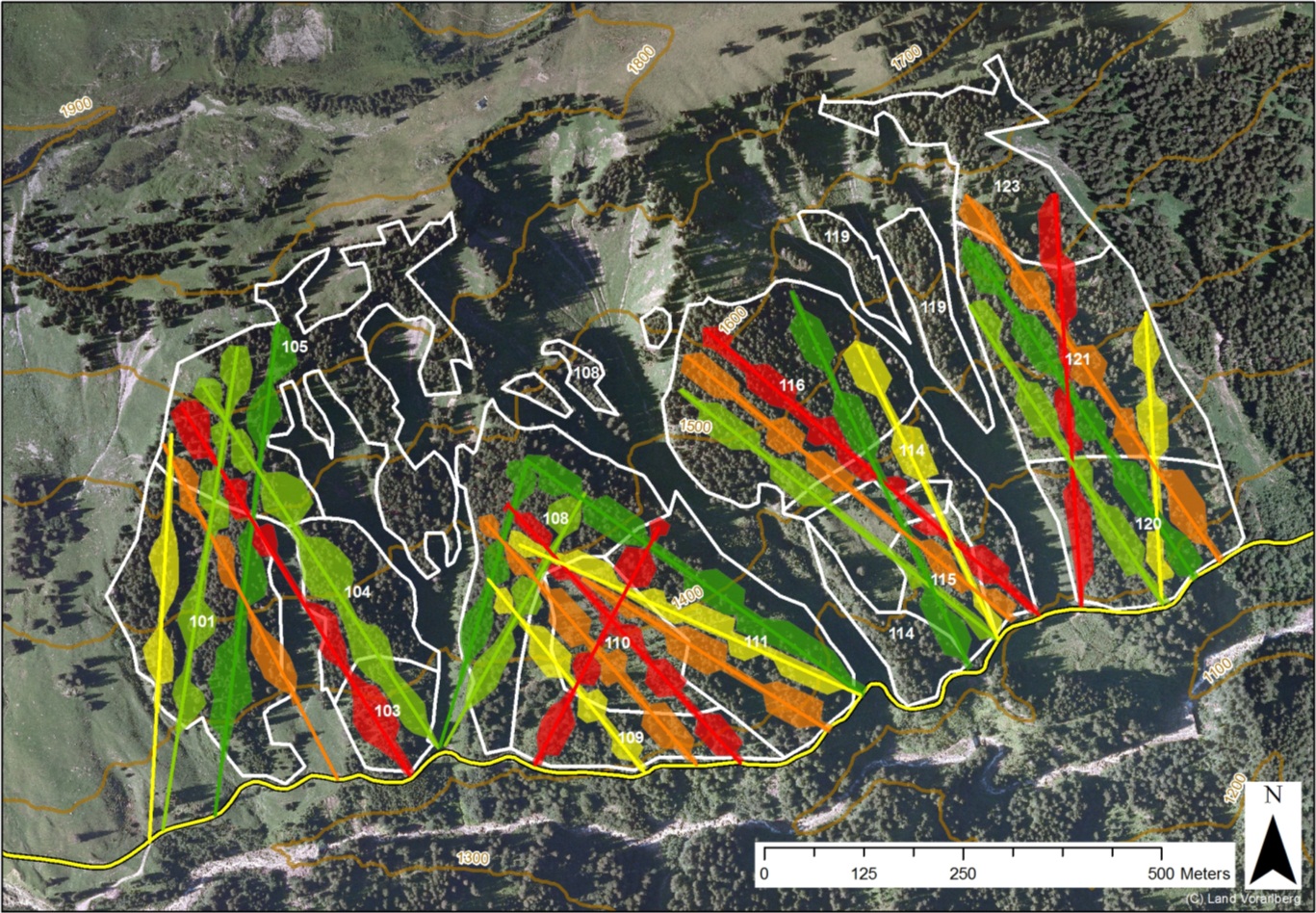
Figure MO-3: Slit and patch cuts as performed under current management as planned over 100 years for a forest compartment of ca. 70 ha. The colors of the slits cuts and skyline tracks indicate 20 year time periods from green to red (from 2010 to 2110). The stands are displayed in white and the road at the bottom of the slope in yellow. This approach results in a virtual rotation period of 250 years.
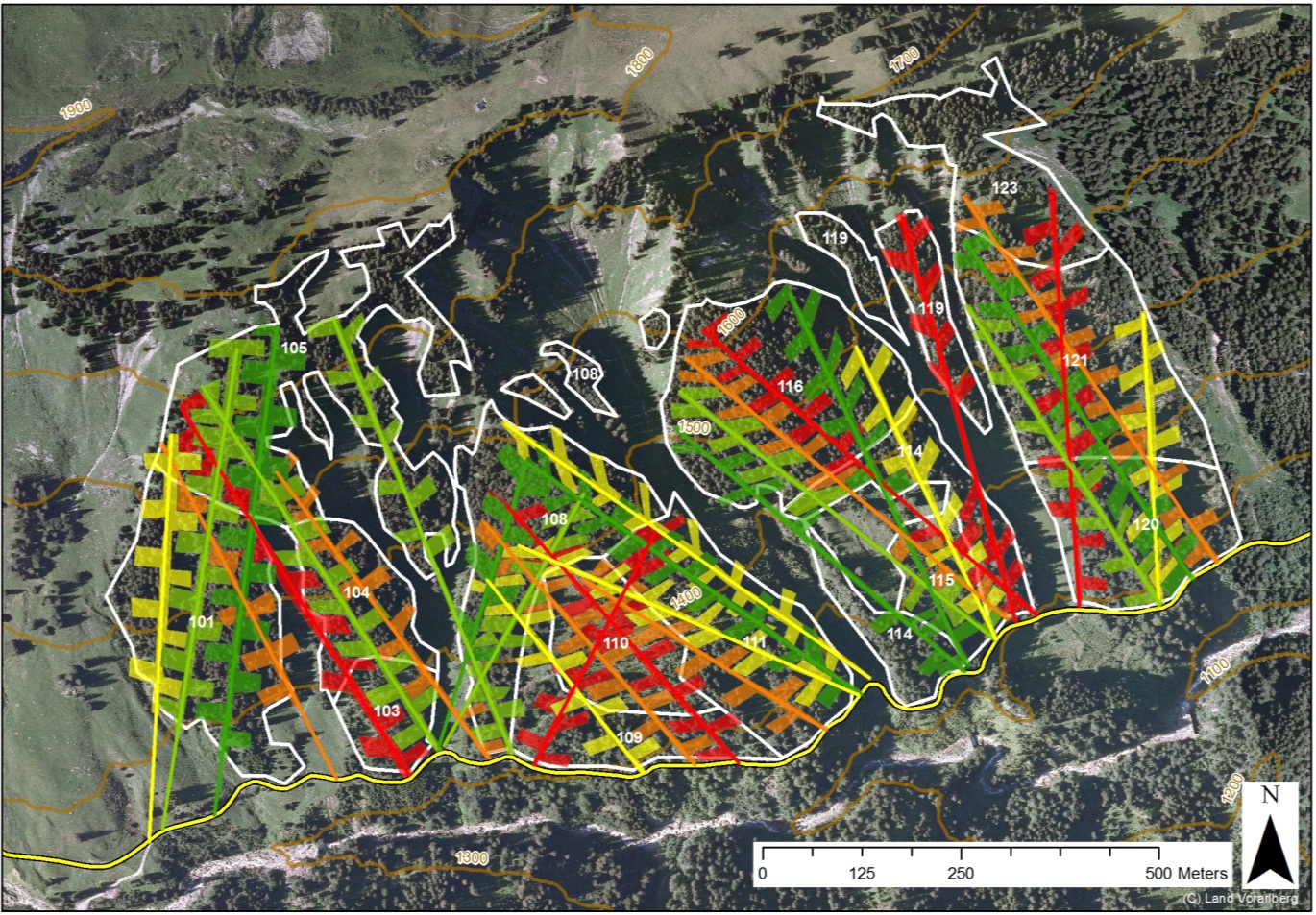
Figure MO-4: Fishbone shaped slit cuts as proposed as an adaptation measure planned over 100 years for a forest compartment of ca. 70 ha. The colors of the slits cuts and skyline tracks indicate 20 year time periods from green to red (from 2010 to 2110). The stands are displayed in white and the road at the bottom of the slope in yellow. This approach results in a faster turnover of tree generations by 20%.
In order to sustain the longterm provision of demanded ecosystem services under a changing climate it is recommended to combine all these adaptation measures (species composition, spatial structure of silvicultural measures and management intensity, game management) (Figure MO-5).
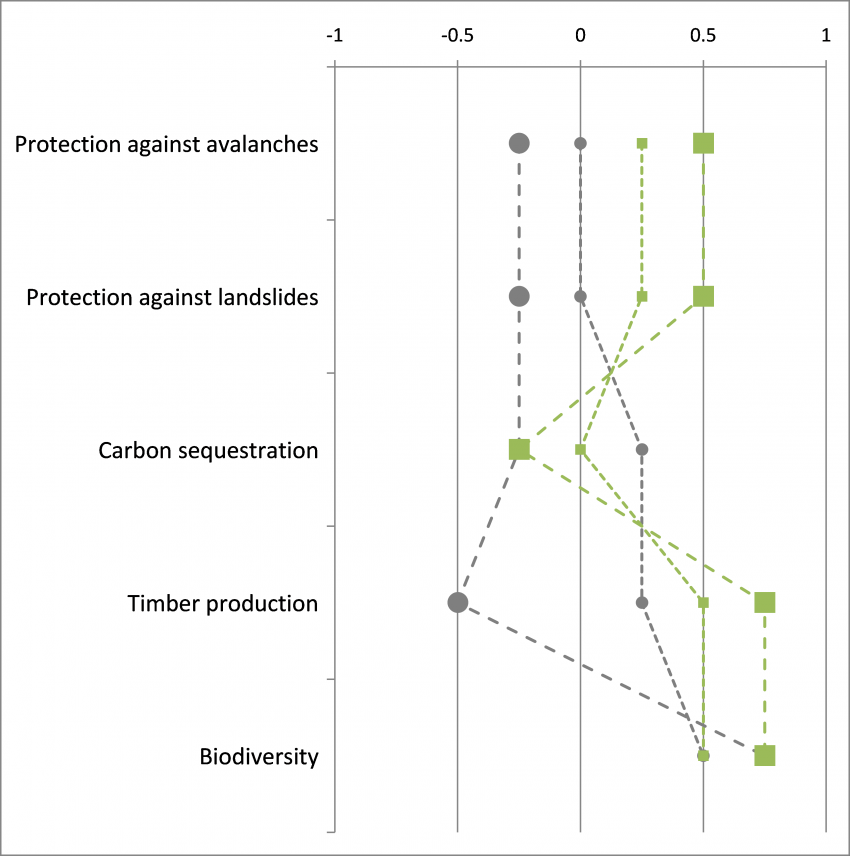
Figure MO-5: Qualitative performance profiles of current management (grey circles) and recommended management (green squares) under climate change. The smaller symbols represent the midterm period from 2020 to 2050, the large symbols represent the second half of the 21st century. Especially for the second half of the century strong differences between current and recommended adaptive management can be expected.
Which adaptive measures appear as suitable response to the changing climate in order to sustain the provision of demanded ecosystem services? What is the recommendation to the forest manager? Prades (Spain)
Simulations show that climate change leads to losses in wood production and Soil Expectation Value (SEV) by about 15%. The effects become particularly visible after 2050 (figure PO-1). During the first decades of the simulation under climate change we even observe slightly increased tree growth (Figure PO-1). This is the consequence of CO2 increase combined with temperature increase. Note that the optimal temperature for net photosynthesis of Scots pine is about 27°C at 400 ppm of atm. CO2, which is over the temperature at present. This positive effect of climate change on growth rates disappears and turns into a strongly negative effect when the water availability is reduced beyond a certain threshold reached during the second part of the 21st century after the occurrence of an extreme drought event, with serious consequences for the tree growth in the following years. A downward evolution of basal area and standing stock illustrates a negative growth, which is explained by so-called carbon starvation, a long lasting shortage of metabolites in the plant.
Under climate change and even under present climate there are large differences in Soil Expectation Value (SEV) between the BAU and the best possible management scenarios, which means that management is an effective tool to adapt to climate change. The best management scenarios (with best SEV, highest wood production – WP – and highest water use efficiency – WUE) for Scots pine under climate change consists of one precommercial thinning, two or three thinnings and a final cut, with a total rotation length of about 60 years. In general more cuts and longer rotation lengths are found optimal for more drought sensitive sites. Concerning optimal management, there are no large trade-offs between SEV, WP and WUE.
In general managers are recommended to follow a more intensive management which reduces canopy density. The effect of this is a decrease of competition between trees, which means more water available per tree, less mortality, and better overall growth performance.
Which adaptive measures appear as suitable response to the changing climate in order to sustain the provision of demanded ecosystem services? What is the recommendation to the forest manager?
Several possible management scenarios were defined: the business as usual (BAU) management and two adaptive management scenarios. The table RO-2 depicts the management scenarios for even-aged mixed Norway spruce and silver fir stands that cover 57.2% of the Frasin forest area, when even-age shelter applies. Soil type is district cambisol, with average availability of nutrients and high water availability. For this stand and site types, the provision of the timber production will change for less profitable forest species, while the biodiversity will strongly increase. The recommendation for adaptative management consist in an increase of the harvesting intensities and a decrease of the cutting ages.
Table RO-2. The management scenarios and their effect on the ecosystem services
|
|
BAU, 2100 |
AM 1, 2100 |
AM 2, 2100 |
| Addressed climate change effect |
none |
moderate drought |
high drought |
| Thinning type |
combined (60% below, 40 % above) |
above |
above |
| Thinning intensity |
average |
average-high |
high |
| Entry interval |
10 years |
10 years |
10 years |
| Expected level for addressed objectives: |
|
|
|
| – Net primary production |
high |
high-moderate |
moderate |
| – soil protection |
average |
average |
average-high |
| – biodiversity |
low |
moderate |
high |
For even-aged mixed Norway spruce and silver fir in shelterwood system, BAU management forecast five interventions for thinning and 120 year rotation while AM2 introduces six intervention for thinning and reduces the rotation length at 100 years. The harvesting intensities were simulated on the basis of optimum stand densities presented in Romanian yield tables, taking into account the existing legal constraints on forest management.
Results/Recommendations
Currently, no management measures in view to adapt to climate change are taken by the forest management authorities. The legislative frame does not give many options to cope with the climate change hazards. However, the results of the BAU scenario indicates that there is a need to consider the impact of climate change in the regeneration of the existing old stands, e.g. take into consideration the expected species shift, control and prevent insect attacks, include the windthrow risk in forest management decisions.
Adaptive management will require as a first step to increase the thinning intensity. More generally, avoiding large biomass stocks would be the most efficient way to improve the water balance of the stands (less interception and less evapotranspiration) and, in the same time, the occurrence of catastrophic windthrow events. As a second step, in regenerating the stands, drought-resistant and windthrow resistant species should be favored. In any case, the Norway spruce proportion will significantly decrease at elevations lower that 800 m. This aspect is a consequence of the fact that many pure Norway spruce stands existing today were artificially created in the period 1960-1980. In that sense, the climate change risk should push the managers back to the naturally existing type of the forests.
The forest managers should take into account a potential severe reduction of the income, as far as the biomass should be lower than today, and that regardless the management type or the climatic scenarios used.
Which adaptive measures appear as suitable response to the changing climate in order to sustain the provision of demanded ecosystem services? What is the recommendation to the forest manager?
The Species Diversification storyline did not adversely affect the ecosystem services indicators compared to BAU, although our analysis did not examine the impact on timber quality.
Analysis of growth trajectories with the different climate model variants indicated that Diversification is a lower risk option than BAU. This is because the species set in this case was matched to cope with a broader range of potential future climate conditions. However a diversification strategy, while only having a minor impact upon modelled timber outturn volumes, would introduce species which have not yet been trialled widely in British conditions.
The Short-Rotation Forestry (SRF) storyline showed an apparent loss in carbon and outturn volume over time. However, a whole carbon lifecycle analysis would be required to understand the carbon effects in detail, for example the benefit of substitution of fossil fuels with biomass. To mitigate habitat loss, an SRF strategy also retains areas of Norway Spruce and Scots Pine on long rotations, which leads to those stands having a very high risk of sustaining wind damage in Clocaenog.
The Low-Impact Silvicultural Systems (LISS) storyline showed an improvement in recreation landscape value and standing carbon sequestration in the longer term. However, essentially there were two possible climate outcomes depending on the model variant: i.e. it warms and dries (e.g. 3q4) in which case the BAU and LISS species choices become vulnerable and lower yielding; or it warms only (e.g. 3q6), in which case Sitka spruce remains as the most suitable species and therefore any alteration reduces suitability and yield.
The Diversification storyline resulted in much closer trajectories between climate model variants than Business as Usual (see example for Clocaenog forest above). Where the Diversification storyline resulted in lower indices than BAU, this was because the climate model variant indicated that the climate warms but stays relatively moist, resulting in a yield class increase for Sitka spruce. The Diversification storyline forcibly removes Sitka spruce from certain sites and the next best species, commonly Grand fir or Noble fir, is lower yielding and has poorer Carbon storage potential. The increased wind hazard in the Diversification storyline was due to the introduction of birch in upland conditions and the narrow taper leads to birch being classed as high risk in ForestGALES. In some cases wind risk declines under diversification due to the substitution of fast growing Spruce with slower growing Pine species.
The LISS storyline carries forward the same species as BAU, but in practice the understory could be a different species (this was not modelled for the case study). So in the LISS simulations, the yield and suitability can drop over time despite the possibility that regeneration would in reality adapt well to the site, or a different species could be underplanted.
The modelling exercise illustrated that the growth of both case study forests followed a sequence of large peaks and troughs. This was associated with the felling and restocking cycles in forests that have low age structure diversity. In this study the modelling framework did not attempt to restructure this by extending or contracting felling periods, which is what would happen in practice. However LISS management did give an impression of how output might be smoothed through alternative management to clearfelling.
Gwydyr forest can largely be converted to LISS which would allow standing biomass to be maintained through the century (below –top graph). Clocaenog, in contrast, is less suitable for LISS due to exposure, so the peaks and troughs will have to be managed in practice by adjusting rotation lengths (below – lower graph).
Overall, the storylines did not affect ecosystem services as much as expected. This was in part attributable to a legacy which lacked structural diversity, due to large areas being planted around the same time. As a consequence, some of the impacts were not fully illustrated within the period 2010-2080 as several stands were not available for restock until 2050 or later.
Which obstacles are limiting the implementation of adaptive management? North Karelia (Finland)
Adaption of forests and forest ecosystems to the climate change can be improved by proper management. In fact, regular and timely management and harvest make it possible to modify the growing conditions and properties of tree populations and communities to allow easier adaption than that possible when excluding intentional management disturbances. Adaptation is nothing to occur in the future but actions are needed now in anticipation to the future conditions. In this regard, a major problem is that development and human acceptance of necessary actions is highly speculative and susceptible to uncertainties in the development of future climate. Furthermore, the future socio-economic context is unknown, with a need of adaptive forests policy, which is responsive to a wide variety of economic, social, political and environmental circumstance. This implies that the adaption is a long-term process from now onwards, including monitoring of stage of forest ecosystem and analysis of observations for planning and action in short-term time perspective (e.g. ten years) set by the management planning.
Which obstacles are limiting the implementation of adaptive management? Montafon Valley (Austria)
Especially for the successful introduction of new species (European larch) and enhancement of silver fir and broadleaved species, as proposed as an adaptive measure, the browsing pressure is of paramount importance. In addition to that the introduction of new tree species via artificial regeneration in the steep terrain of the Montafon is laborious and costly. However at the moment it is unclear if the SMF, in cooperation with the hunters, will be able to reduce the browsing pressure to an acceptable level. The reason is that the hunting rights are let for rent. The majority (roughly 80%) of the lessees are non-locals which are paying a considerable rent for attractive hunting grounds (i.e. hunting districts with a high abundance of attractive game species like red deer or chamois). The rent for the hunting districts is a substantial source of income for the SMF. This leads to two problems with regard to the implementation of the adaptation measures. First reducing game populations will eventually reduce the value of the hunting districts and the SMF will create less income from rents. Secondly non-local hunters will not be able to execute the increased shooting plans, which means that the SFM has to find motivated local hunters which most probably will not be able and willing to pay as much as the non-locals. This means that for a successful implementation of the recommended management the organization of hunting in the case study needs to be changed dramatically.
Which obstacles are limiting the implementation of adaptive management? Prades (Spain)
A recent study by Kristina Blennow (SLU) in PLOS ONE shows that the major condition for forest owners to take adaptive measures to climate change is to believe in it and to see its effects. In the case of Poblet, both conditions are fulfilled. The local managers have a high level of education and a long lasting interaction with the climate change scientists which have been working in their forest in the last decades. As a consequence the managers have a good understanding of the issue of climate change, and they have also clearly experience the effects of climate change, through increasing mortality as a consequence of more frequent and longer dry spells, especially in holm oak and pine.
In recent years they started adaptive management by increasing thinning intensity decreasing competition between trees. They also stimulate regeneration of drought resistant Mediterranean shrub species, and consider planting them where they are absent.
The main limitation for adaptive forest management is the cost. Forest management operations are expensive, and income from the forest is very limited. Increasing wood prices would be beneficial, as would be increasing income from mushroom permits. In general, ways must be explored to finance adaptive management, considering the importance of payments for ecosystem services (PES) and other economic instruments to internalize forest ecosystem services and non-wood forest products.
Which obstacles are limiting the implementation of adaptive management? South-East Veluwe (Netherlands)
The Dutch Forest law currently does not recognise Tilia as a forest species. Large-scale plantations of Tilia are thus a violation of the Dutch forest law, but in practice this is tolerated by the inspectors.
Part of the current Natura2000-labelled old-growth oak and oak-beech sites would convert to Douglas fir forest under the more extreme climate scenario, and management will only partly be able to retard this conversion. To maintain the characteristic old-growth ground vegetation, conversion to Scots pine forest would be much more favourable than the spontaneous conversion to Douglas fir. Light conditions are much better under Scots pine. However, such a development is in conflict with the Natura2000 rules.
Which obstacles are limiting the implementation of adaptive management? Kronoberg (Sweden)
A major obstacle limiting the implementation of adaptive management is the forest owners’ personal perceptions of local effects of climate change. When forest owners believe in and see the effects of climate change, they are more likely to have taken adaptive measures. These two personal factors almost completely explain and predict forest owners´ adaptation to climate change (Blennow et al. 2012) The forest owners who have taken measures to adapt their forest management to climate change often see wind damage as the climate-change risk that increases the most (Blennow, 2012).
Which obstacles are limiting the implementation of adaptive management? Carpathians (Romania)
For the introduction of new broad-leaves species there are currently two contradictory trends, and therefore two kind of obstacles. In one hand it seems that broadleaves are coming back and are replacing Norway spruce, at least in clear cut areas formerly composed by Norway spruce stands. The preliminary results of on-going sociological inquiries in the area show that forest managers tend to prefer the Norway spruce in the regeneration and to neglect/eliminate if possible in prunning/cleaning/thinning the other species. On the other hand, it seems that under the shelter-wood cutting system, largely practiced and prescribed in the management plan, the broadleaves species (excepting beech) do not succeed to regenerate, a recent phenomenon (about ten years). One explanation that may be provided is the existing browsing/grazing that concentrate on the patches of broadleaves resulted after the regeneration works (Schultze, personal communication). Thus we may underline that for the changes in the species composition the main obstacle are: 1) the forest managers (and owners) preference for Norway spruce, more income-promising than beech-based stands, and 2) the high browsing/grazing pressure that can not be easily solved.
The obstacles are different when the solution proposed concerns the reduction of the harvesting age (rotation length) or the increase of the thinning intensity. The harvesting age is determined in the forest management plan as implementation of very strict rules with law force. The harvesting age is established according to the type of the stand (composition, productivity) and the forest ecosystem functions. Therefore there is a legal obstacle for modifying the harvesting age, because it is established by law, compulsory for all forest owners, and can not be modified locally according the forest managers’ experience or owners’ needs in terms of wood assortments. The same obstacle applies for the thinning intensity which is not as strictly imposed by the technical norms as the rotation age but rather it is a consequence of practitioners’ fear to act by their experience (they prefer to use some average values recommended by norms). Another obstacle related to thinning is the low value of wood that make the works unattractive for the harvesting companies, particularly if the thinning has to be done in stands with low accessibility or strong slopes. We expect that the problem of too low thinning intensity and frequency will not be solved soon.
Finally, several obstacles may affect the forest managers capacity to react and to adapt, e.g. too long and bureaucratic process for obtaining the permit to harvest the infested trees and stands in case of insect attacks; lack of forest road infrastructure (national average is 5.6 m of forest road per ha) that limit the forest managers capacity to intervene in case of disturbances; unbalanced age structure that offers little room to adapt the management once the harvesting is done.
Which obstacles are limiting the implementation of adaptive management? Wales (UK)
Our previously limited experience of some of the species that appear useful for climate change adaptation is being improved with new species trials that are now underway. However, where site quality is poor (due to exposure and/or soil nutrient status), the range of species available for planting will remain limited.
Conversion to continuous cover forestry (CCF) is constrained by wind exposure to lower elevation sites, and implementation rates of all adaptation options are constrained by operational restrictions, i.e. less than 1% of the forest can be converted each year.
Which obstacles limit the implementation of the adaptive management? Panagyurishte (Bulgaria)
Even the adaptive management activities are not able to fullfil some of the negative consequences of the predicted by climate scenarios changes. This could raise negativism between the stakeholders, which have to implement some restrictions or nonprofitable measures. The possible unpredictable behavior of the great number of small private forest owners as well as the relatively weak capacity of the municipal forest managers could lead to short term interventions in some stands (clear cuts, overgrazing, over thinning, planting of non adequate species and so on.), with long-term negative impact. The existing standards of the forest inventory and planning have also to be adjusted to the recommended adaption measures.
The dissemination of knowledge, as well as the active information flows to all potential stakeholders (mainly the local citizens) and decision makers should be disposed to overcome these possible obstacles.
Will the risk profile of tree species change under climate change? Carpathians (Romania)
Wind throw is expected to have an increasing impact in the disturbances regime, and to affect larger area (to have an increased frequency of the catastrophic events). There is a significant risk that the areas affected by the wind throw would be difficult to regenerate with the main tree species, if climate is warmer (risk of drought). We have in the site examples from private forests cut down ten years ago, and still not regenerated, or regenerated with pioneer species like birch, aspen or willow.
For Norway spruce there will be an increasing bark beetle infestation risk. Fire risk will increase on Norway spruce stands in a warmer and drier climate. Fire starts usually in the spring time when the landowners are cleaning the arable/grazing lands by fire and it happens that the fire spread out in the forests nearby.
The temperature increase considered by the climatic scenario becomes a handicap for Norway spruce which will suffer or lose the competition with the other species naturally regenerated.
Will the risk profile of tree species change under climate change? Montafon Valley (Austria)
Due to warmer conditions Fagus sylvatica and Acer Pseudoplatanus as well as Fraxinus excelsior will be less affected by winter frost. However the future development of early and late frosts remains uncertain. Another important abiotic factor with large uncertainties with regard to the future development is the snowpack on the steep slopes of the Montafon which causes mortality in seedlings due to snow creeping and gliding. If future conditions feature more frequent wet snow precipitation events damages from snow breakage will increase. Wind throw is currently playing only a minor role in the disturbance regime. This is not expected to change in the future. Given the current and projected climatic conditions forest fires are not a concern in the case study region.
For Norway spruce there will be an increasing bark beetle infestation risk due to better development conditions for poikilothermal insects. Figure MO-1 shows simulated salvage from bark beetle infestations in a warmer climate for the Montafon. Especially during the second half of the 21st century a strong increase in bark beetle (Ips typographus) induced mortality can be expected for Norway spruce. For silver fir the bark beetle risk in the future remains uncertain. There has been less research on insects feeding on Silver fir compared to Norway spruce and the knowledge base is still limited. For ash future development is uncertain because of current severe dieback symptoms caused by the fungus Chalara fraxinea. Reduced precipitation and warmer temperatures may negatively affect conditions for Lachnellula willkommii (larch cancer) and thus improve the growing conditions for European larch.
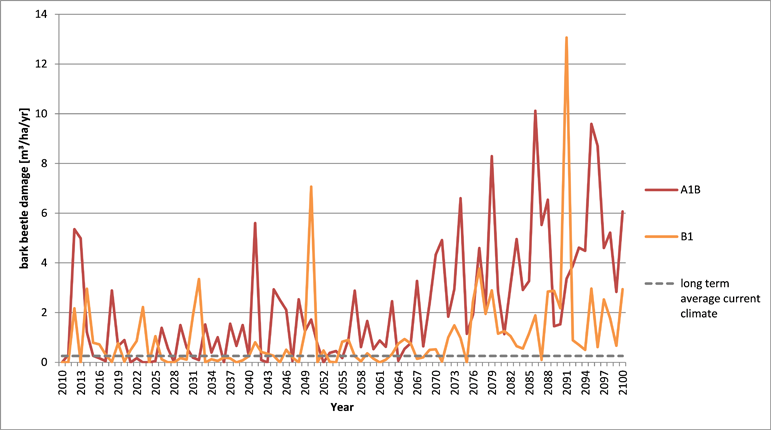
Figure MO-1: Simulated future bark beetle damages for two climate change scenarios under continuation of current management practices (BAU management) in relation to the long term average damage under current climatic conditions.
Will the risk profile of tree species change under climate change? North Karelia (Finland)
Risk profile of different tree species will change along with warming climate in such a way that towards end of this century Norway spruce becomes more vulnerable than Scots pine and birch. High wind speeds and/or heavy snow loading accompanied with shorter duration of soil frost and, thus, reduced tree anchorage may increase the risk of damages regardless of tree species, but especially in Norway spruce with shallow rooting. Uprooted and/or broken trees are also suitable breeding material, e.g. for bark beetles, if not being harvested immediately. In addition, Norway spruce is expected to suffer drought the most and especially in the southern Finland on sites with relatively low water-holding capacity, making it also more vulnerable to insect outbreaks under warmer climate. On the other hand, if the share of Norway spruce may reduce opposite to Scots pine and birch in forests, the mortality of trees due to wind may in general decrease from late autumn to early spring (as birch is leafless) unlike in summer when Scots pine and birch are also vulnerable to wind damage (Figure JO-2).
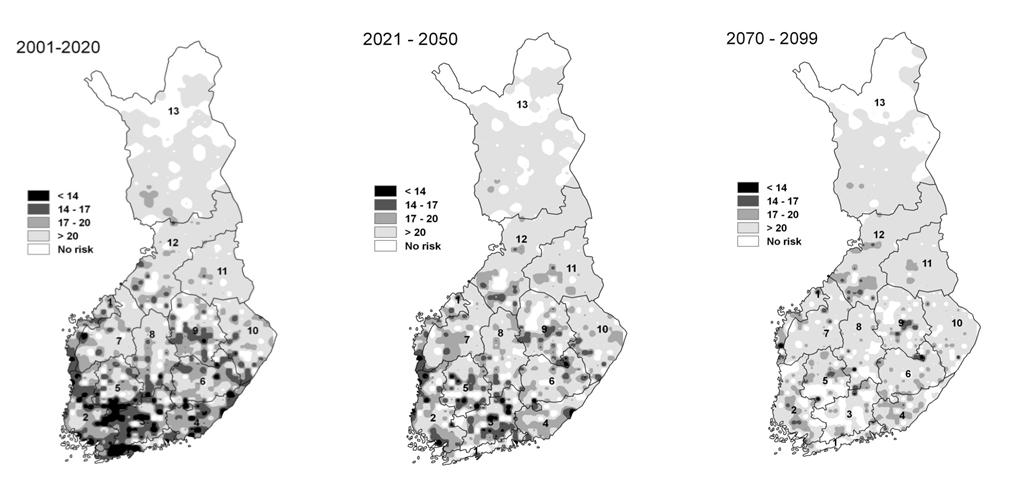
Figure JO-2. Predicted occurrence of different threshold (critical) wind speeds for uprooting of trees in Finland from late autumn to early spring towards end of this century (birch nor consider as being leafless). The decrease of share of lower critical wind speeds is related to possible decrease in the success and share of Norway spruce in tree species composition (opposite to birch and Scots pine), especially in southern Finland, due to increasing drought episodes increase. In the North, higher average dbh/h-ratio of trees and low share of Norway spruce explains the high resistance of forests to wind force. However, in summer the map would look different as in addition to Norway spruce also birch (in leaf) and Scots pine are vulnerable to damage.
Will the risk profile of tree species change under climate change? South-East Veluwe (Netherlands)
Although forest fires are relatively rare, it is considered an important risk in the area. The area is used intensively for recreation purposes and borders several densely populated urban areas. The concern with fires is thus mostly focussed on safety and economic assets rather than the forest itself. Developments towards more broadleaved tree species as found in current and moderate climate change under BAU and IM are considered as helpful to decrease the risk of fire ignition and rapid fire spread. A more extreme climate change would lead to both increased frequency of periods with high-risk weather conditions and a more vulnerable, conifer-dominated vegetation. Under the W+ scenario, maintaining a high share of broadleaves is only possible in the southern zone of the area, and management should thus focus more on managing the continuity and build-up of the fuel in the landscape. A fire risk assessment showed increased fire risk in the heathland, especially at the borders with existing forest, where natural regeneration of coniferous species (mostly Scots pine) occurs.
It is still unclear if storm frequency and intensity will change under changing climate. It is thus mostly changes in the forest structure that will influence future storm risk. The scenarios with gradual increase of broadleaves can be considered as having equal or less risk than nowadays. An increase in dominance of especially Douglas fir might lead to somewhat increased storm risk, since Douglas fir can generally attain higher heights. This is mostly in the W+ climate scenarios and the IM management scenarios. The business as usual management shows an increase in storm risk due to a relatively low management level. Insect risk is deemed highest in the W+ climate due to more drought stress on the trees.
Will the risk profile of tree species change under climate change? Prades (Spain)
Tree species like holm oak that were perfectly adapted to the area in former time show decrease in vitality and even mortality due to recent long drought periods, which probably causes carbon starvation in the trees. Other species that were already at the edge of their distribution range, like Pinus sylvestris increasingly suffer from dieback due to drought stress. The general risk profile of all species changes because of increased fire risk.
Will the risk profile of tree species change under climate change? Wales (UK)
Overall, forest growth models run with the climate projections indicate that the dominant species in these forests, Sitka spruce, is at risk of declining in productivity after 2050 if conditions become drier, while other main species should maintain their productivity. In the event of moisture deficits only changing slightly, Sitka spruce yields might increase substantially where temperature has hitherto been a limiting factor. However in Clocaenog, increased growth rates will also expose trees to higher risk of storm damage earlier than might have been otherwise expected.
